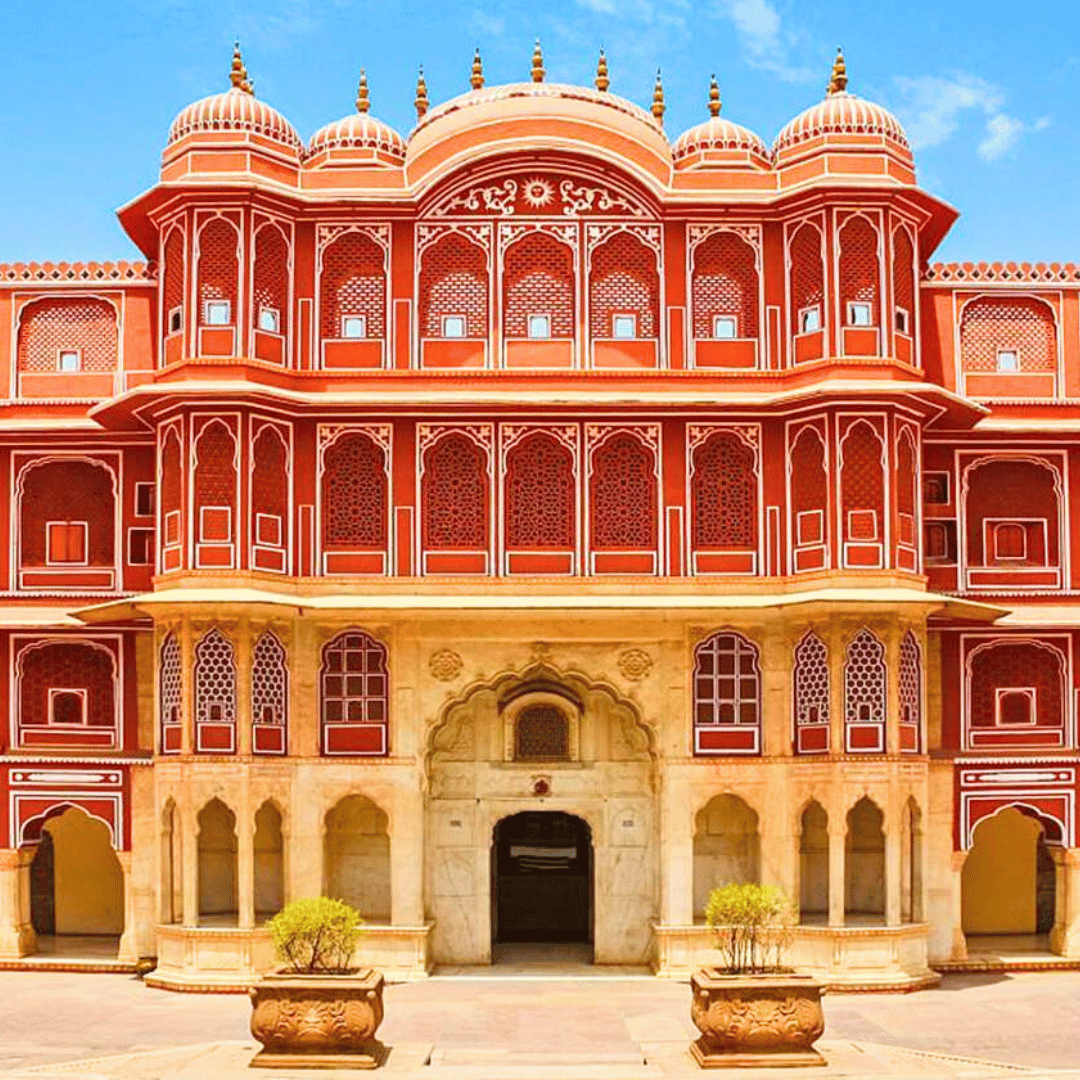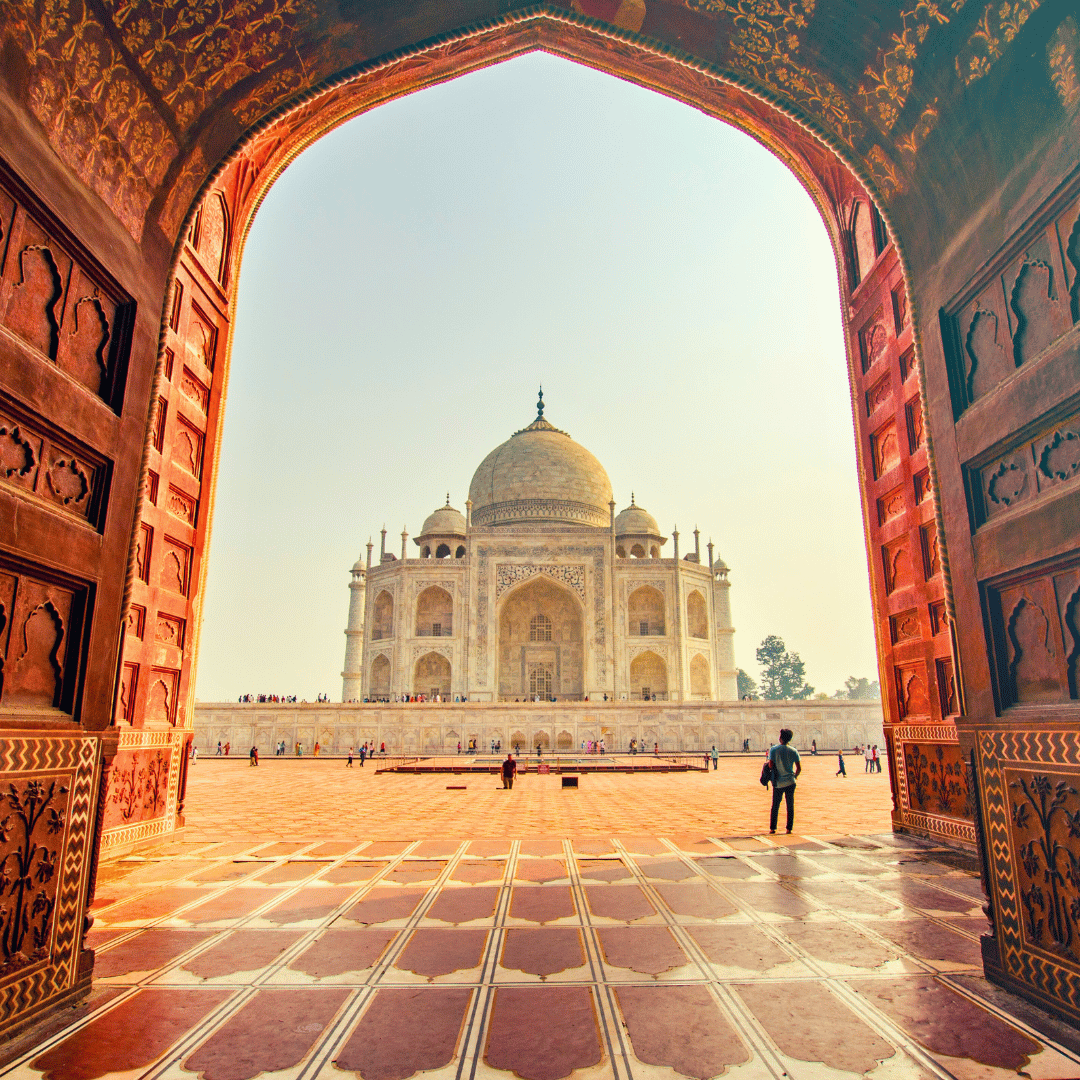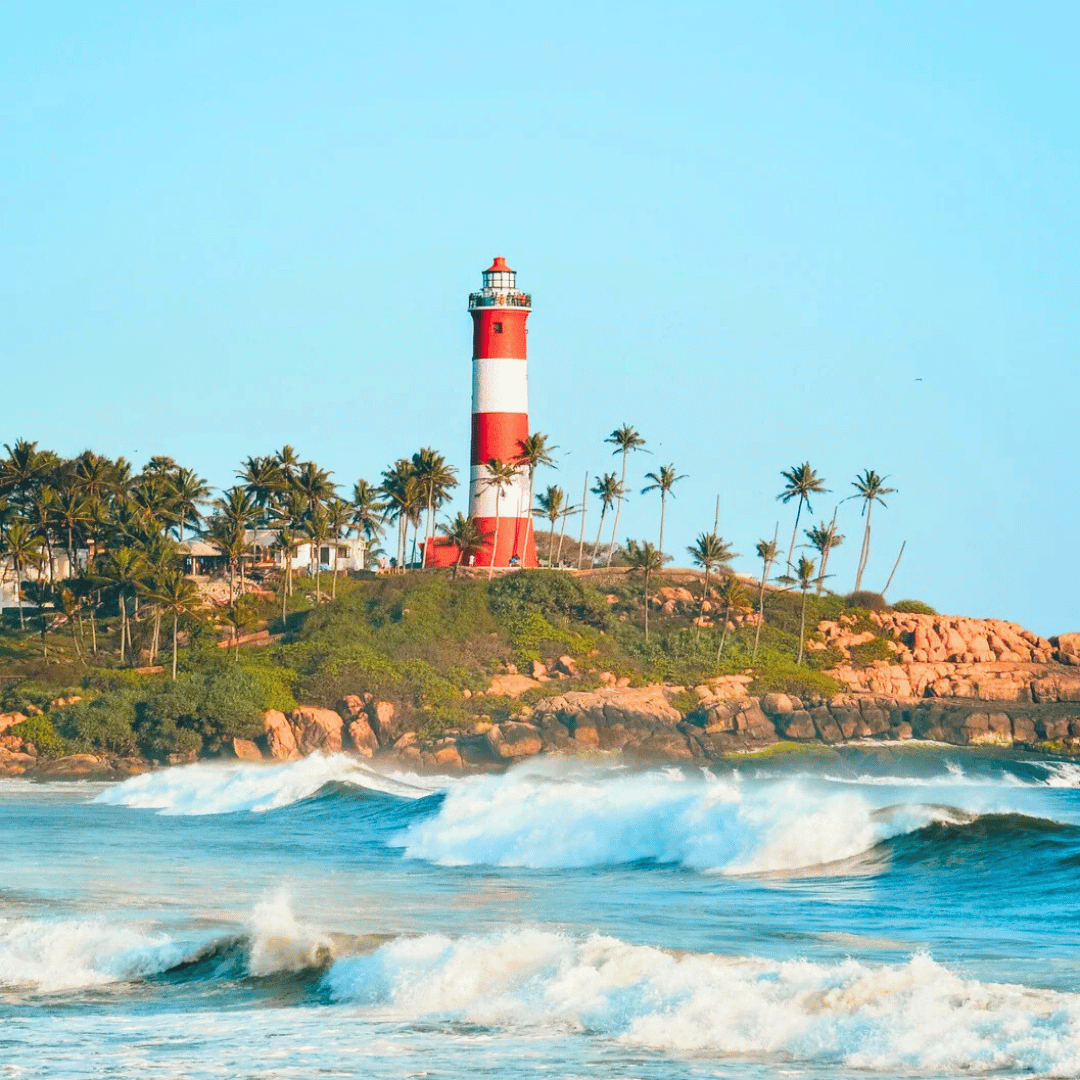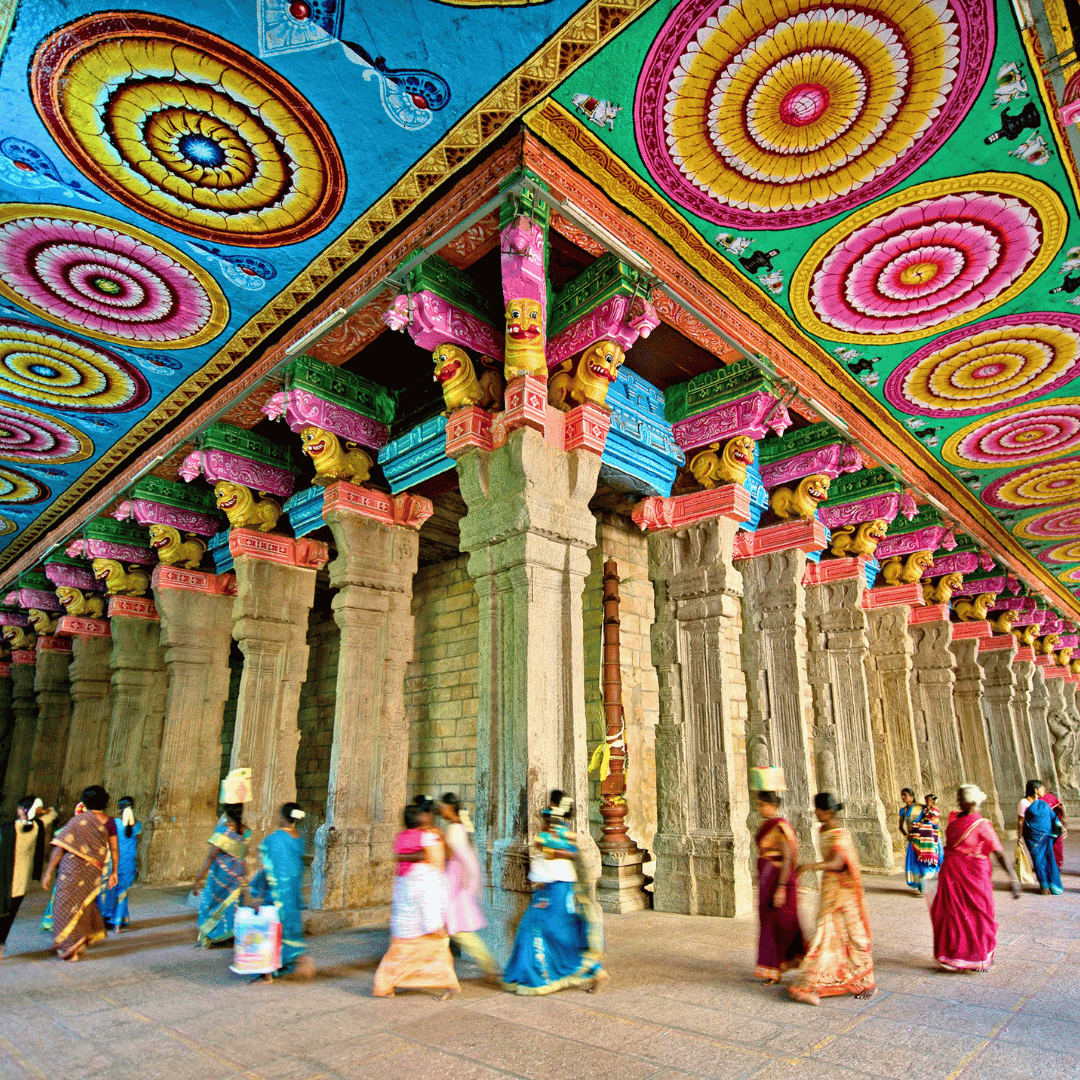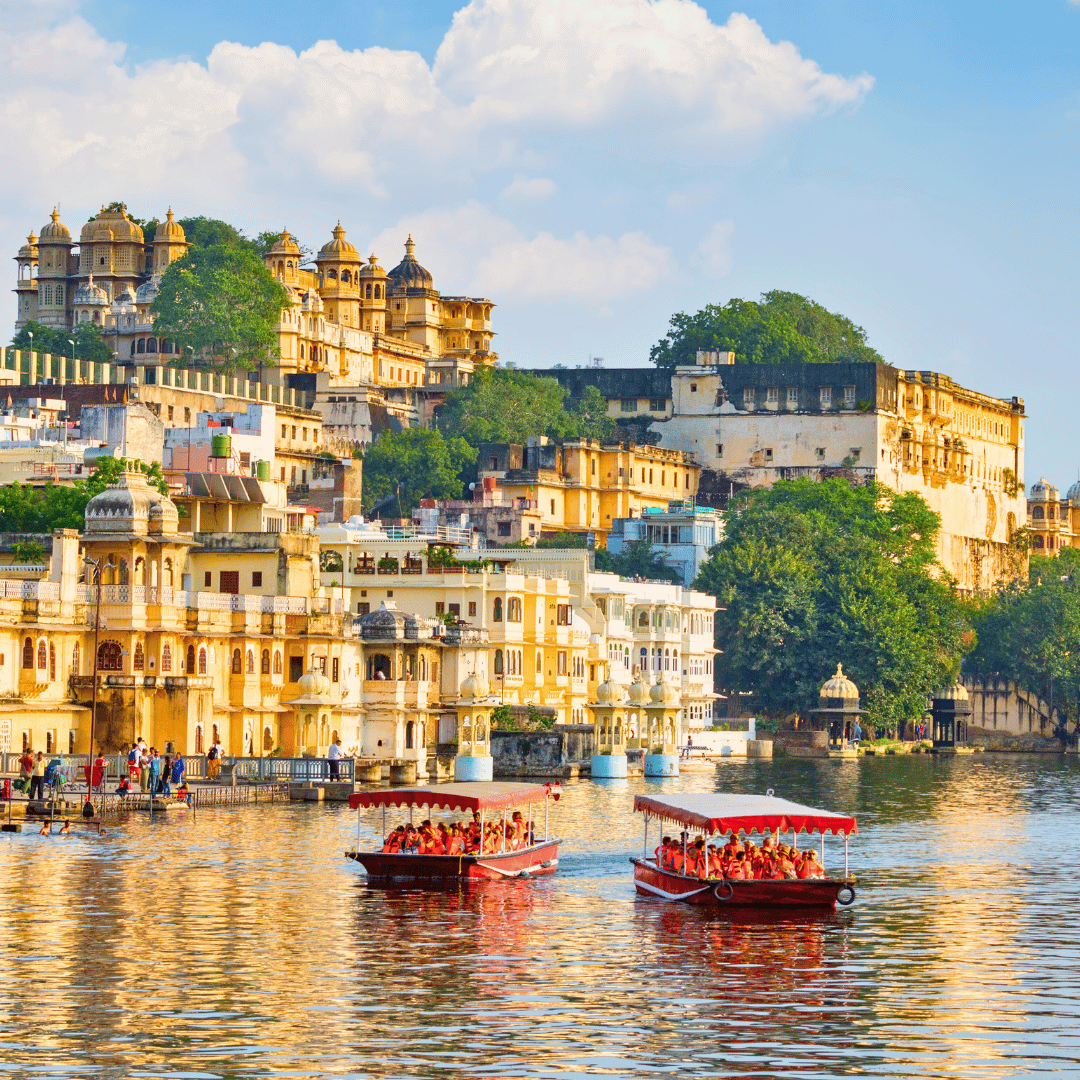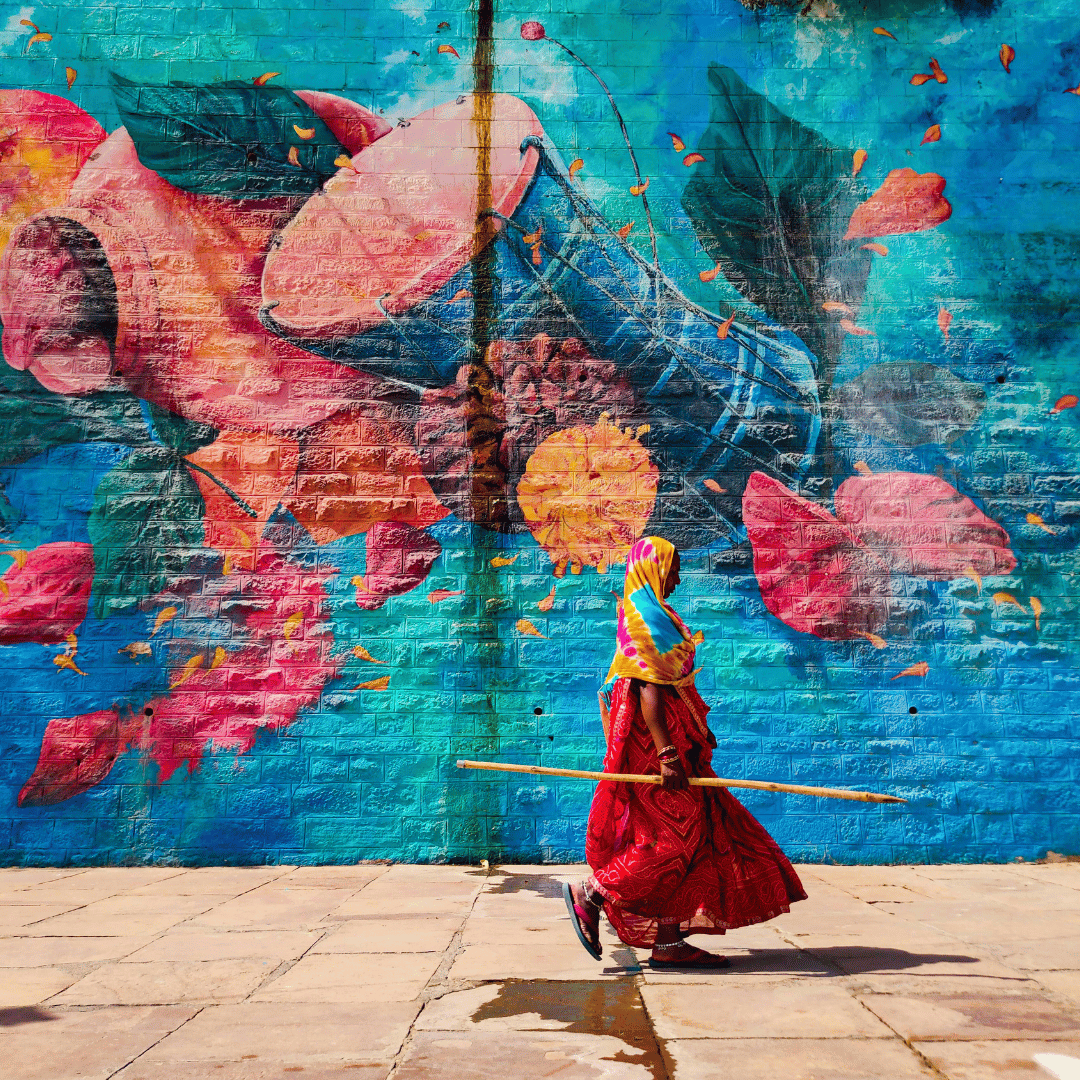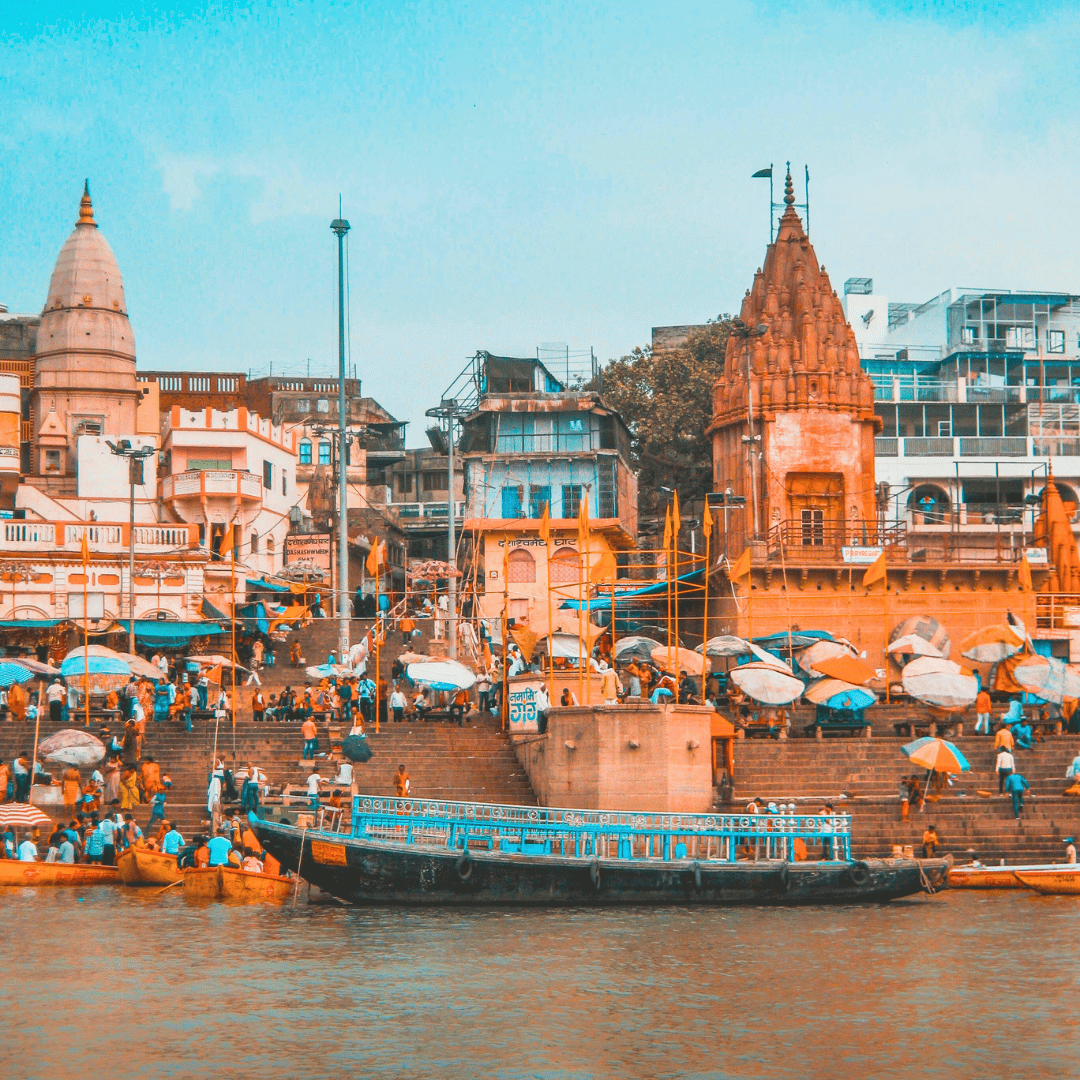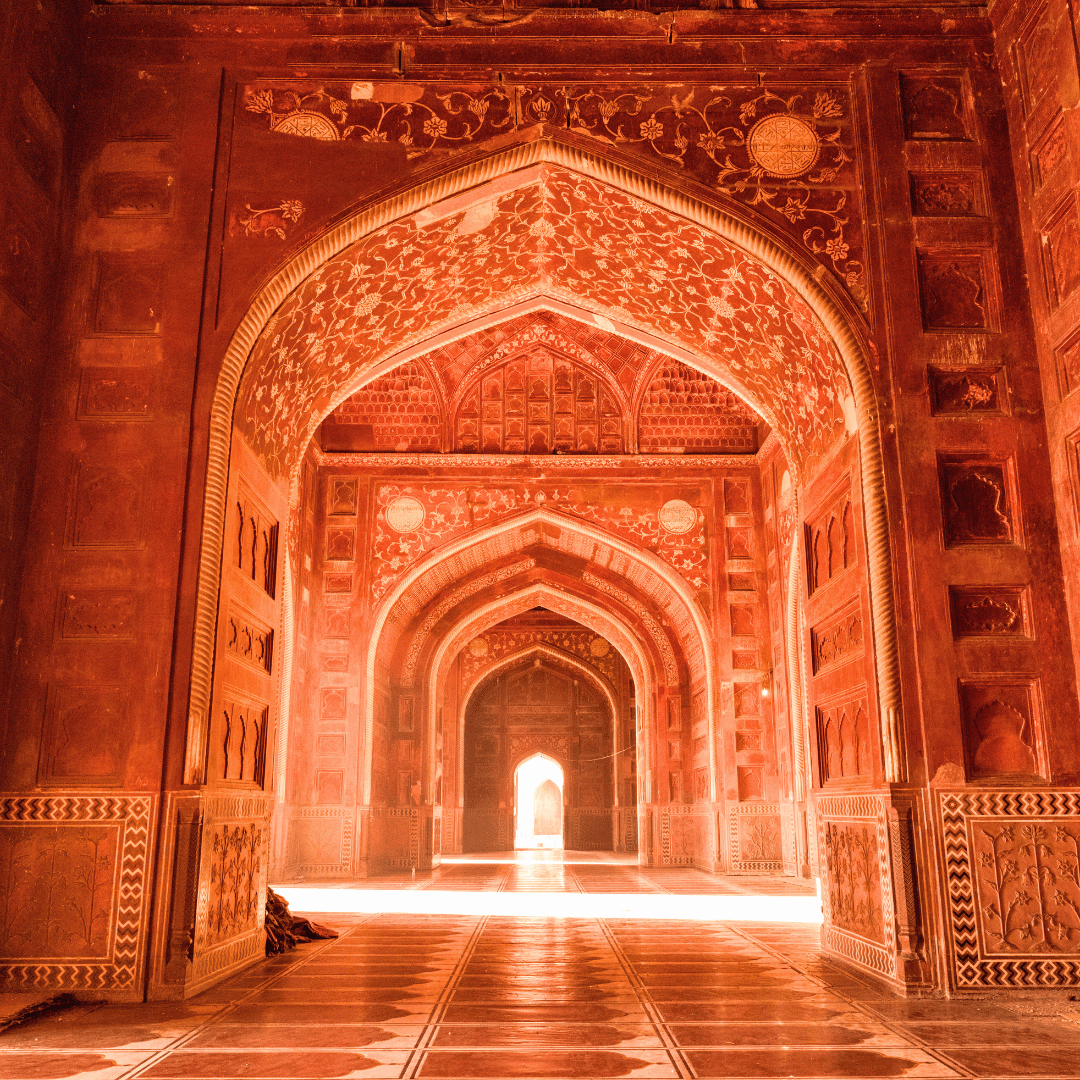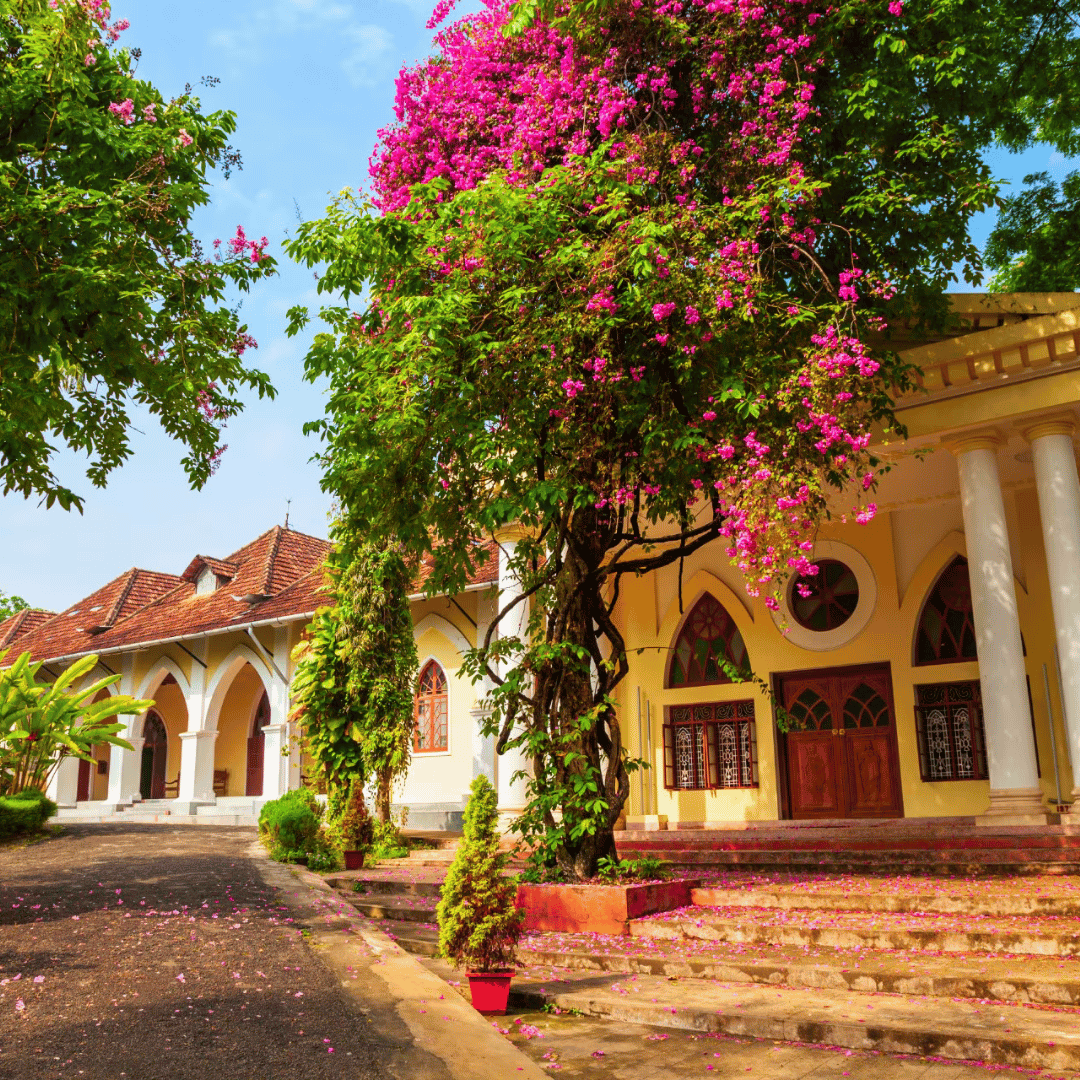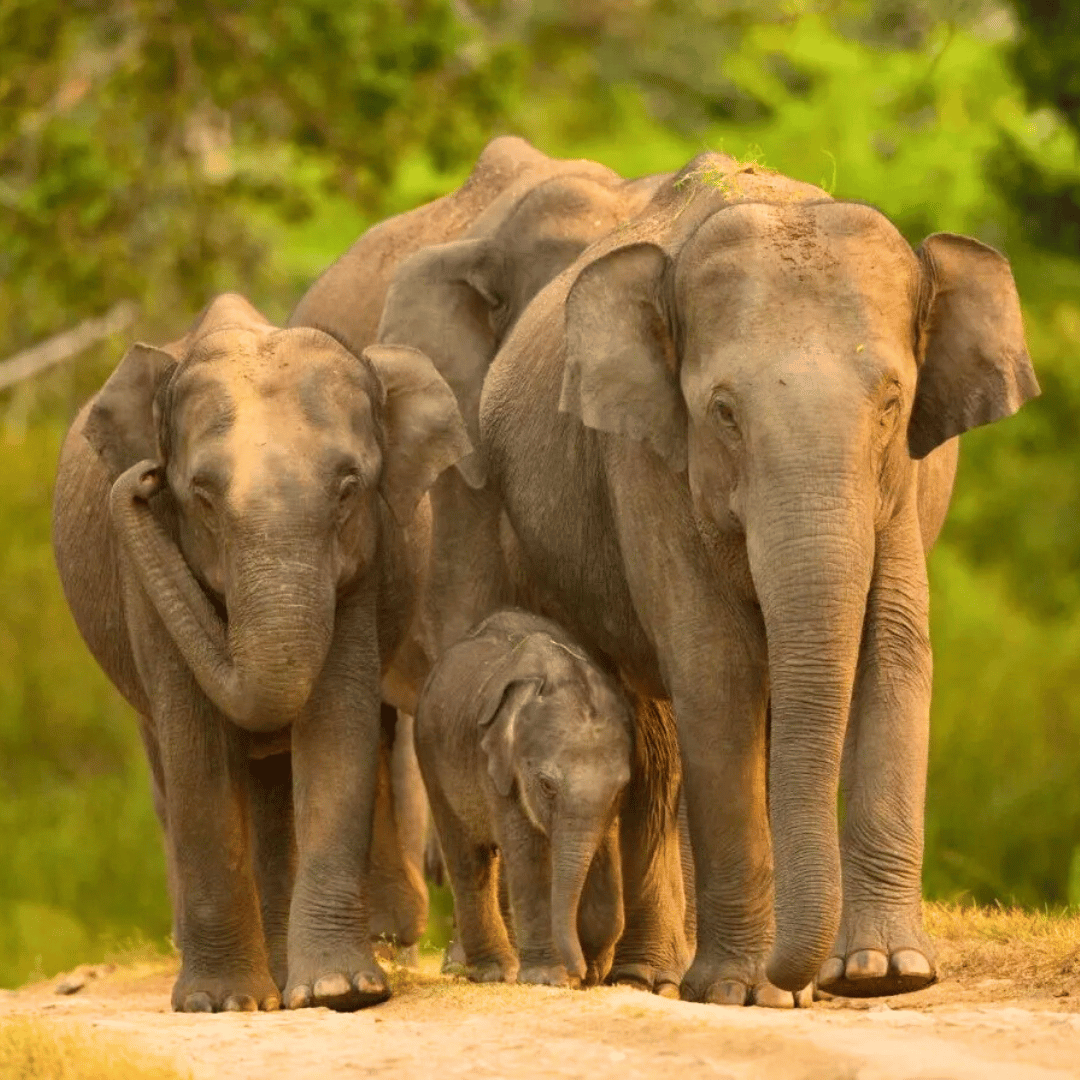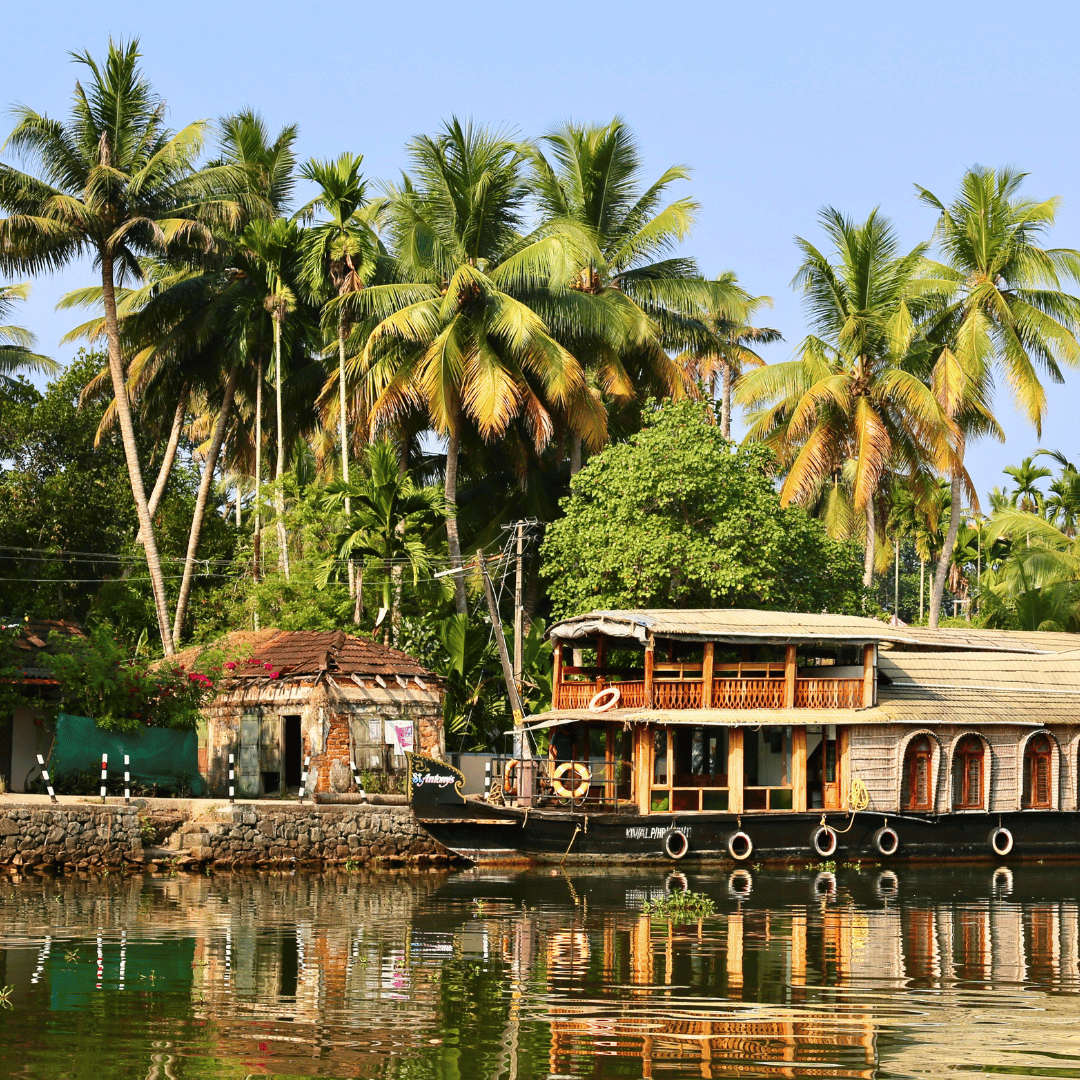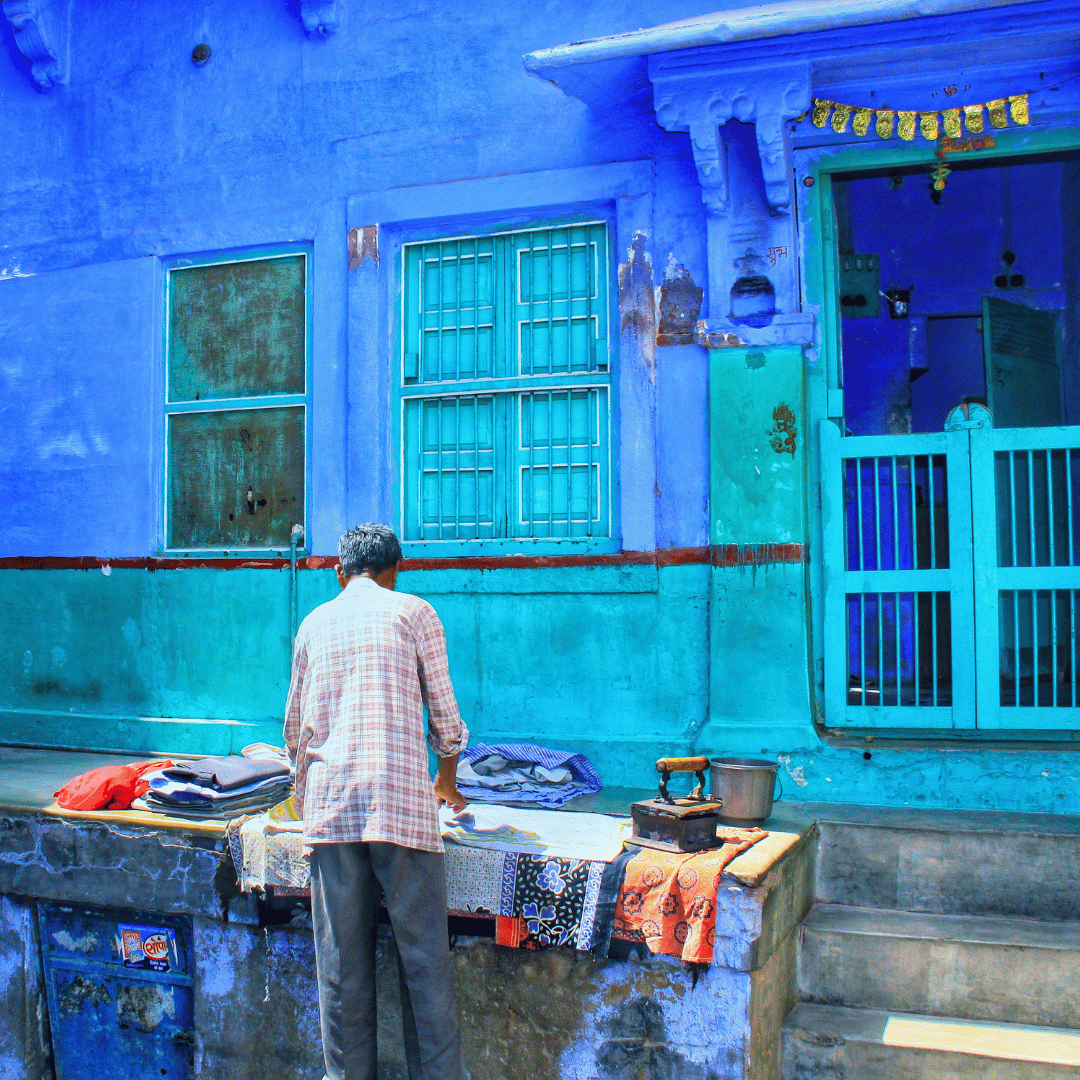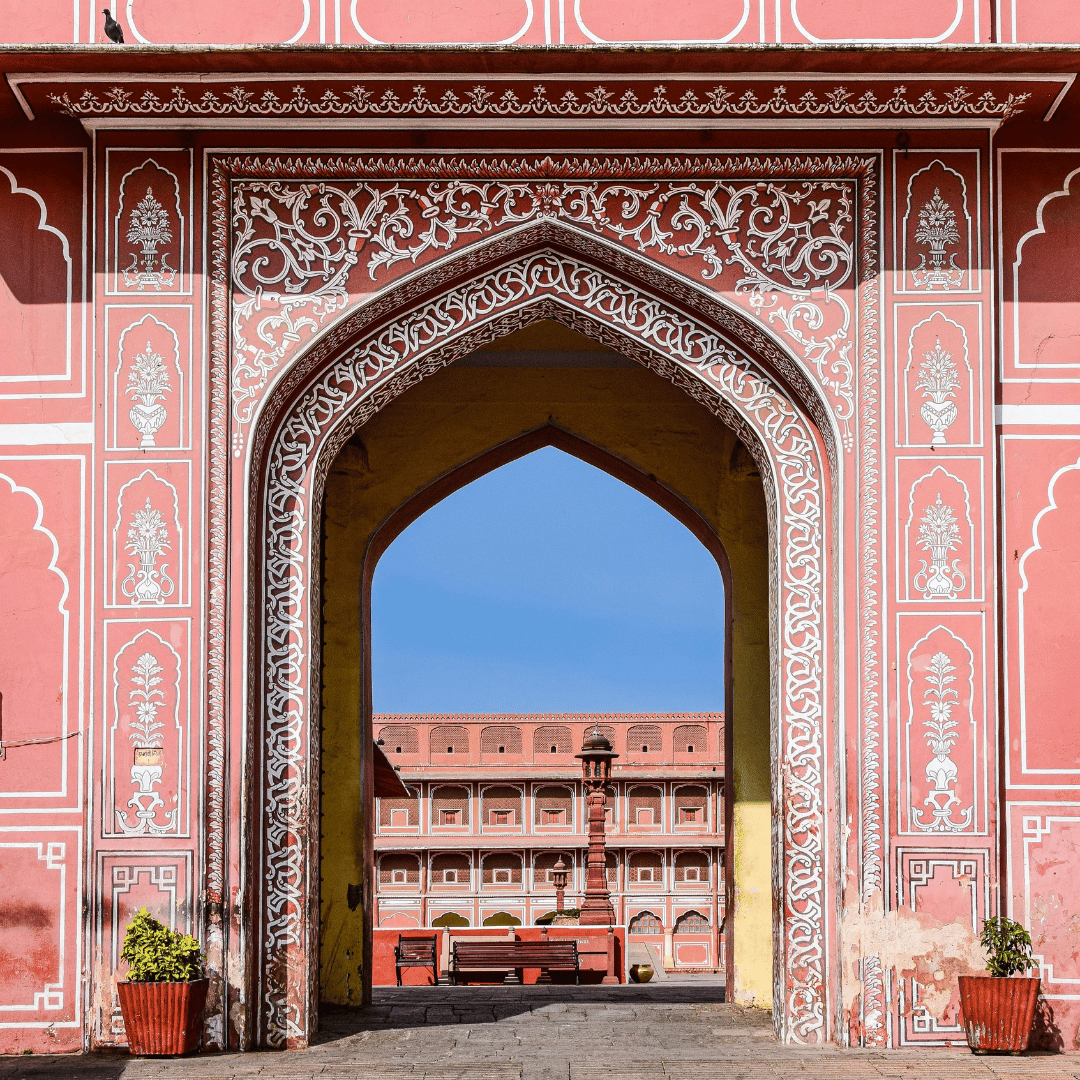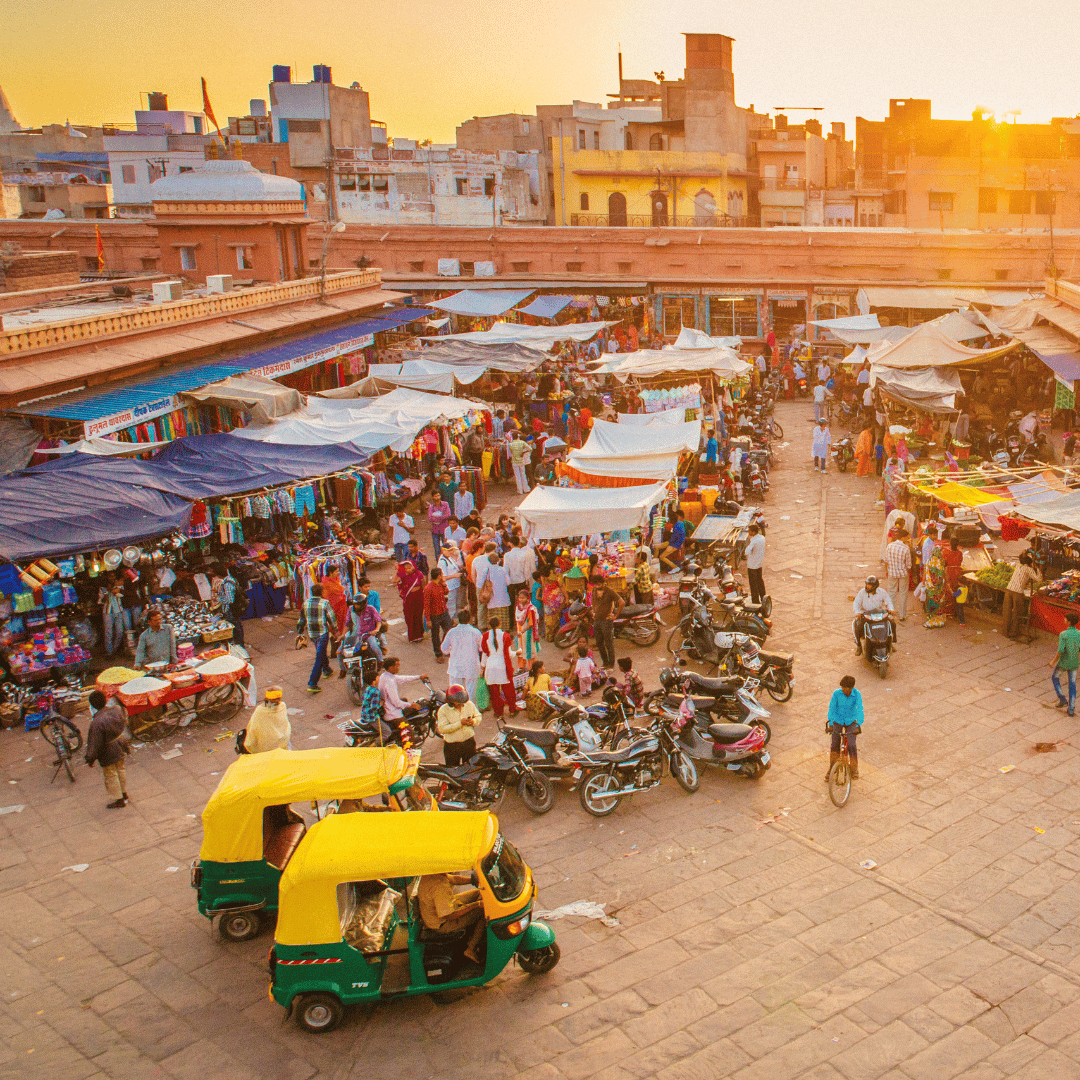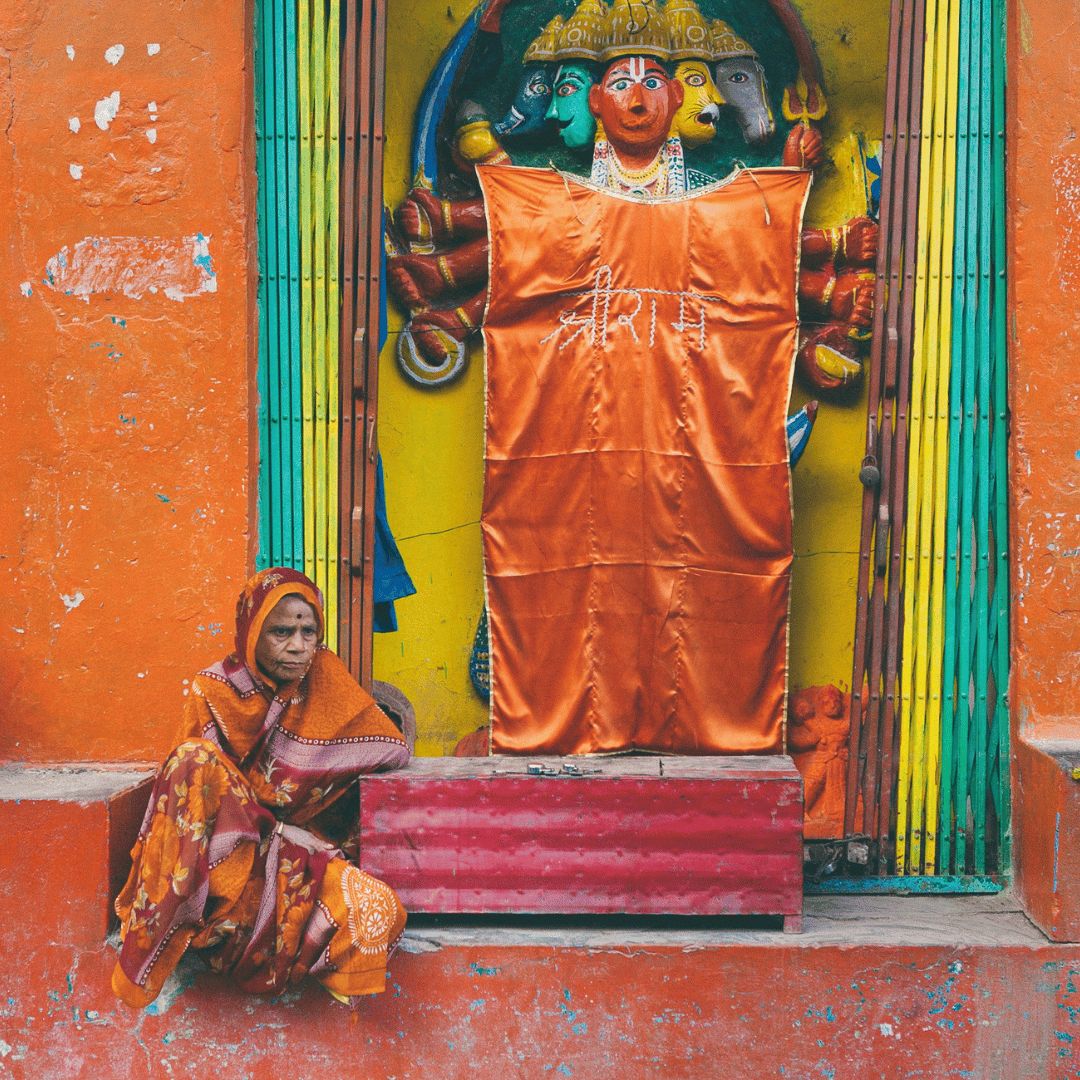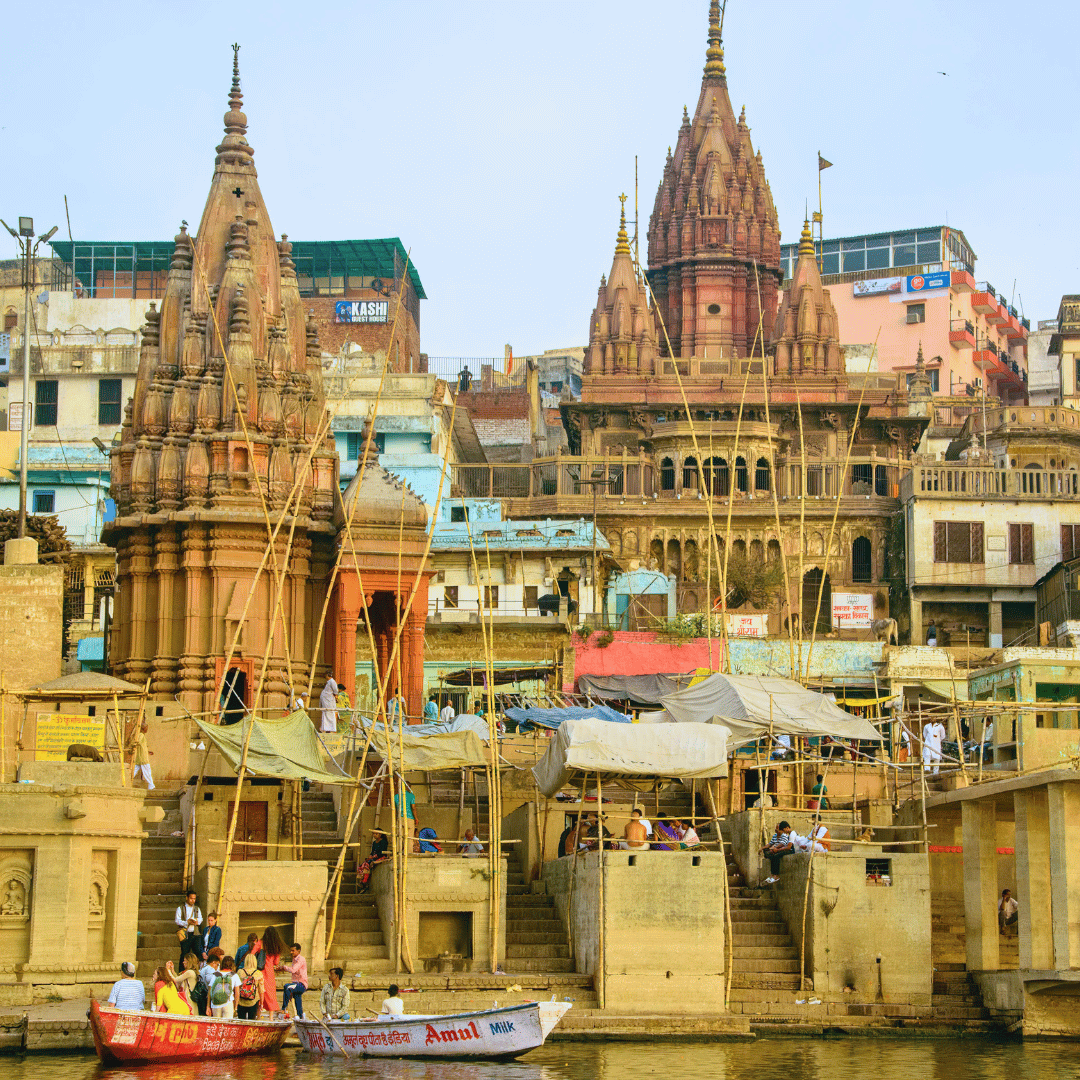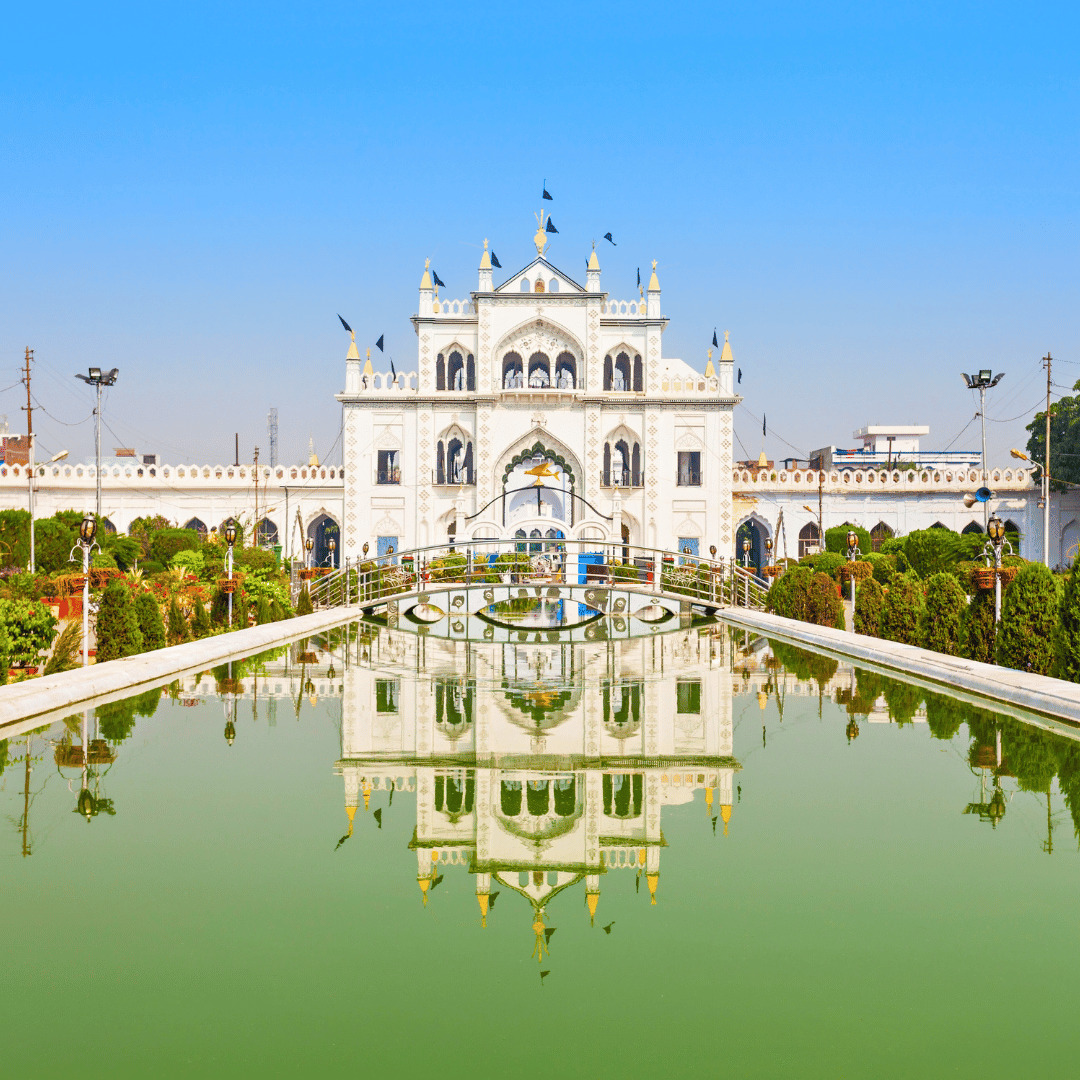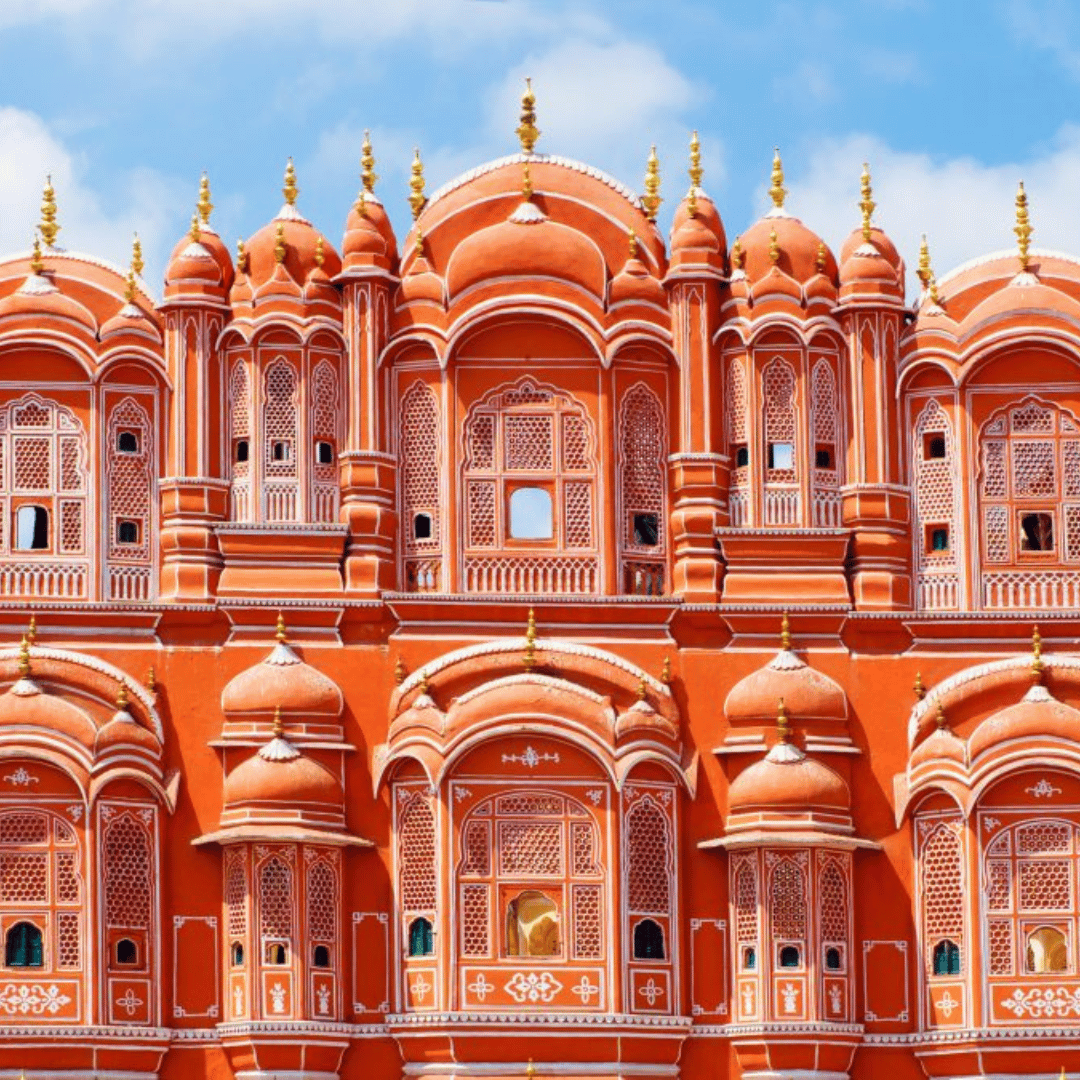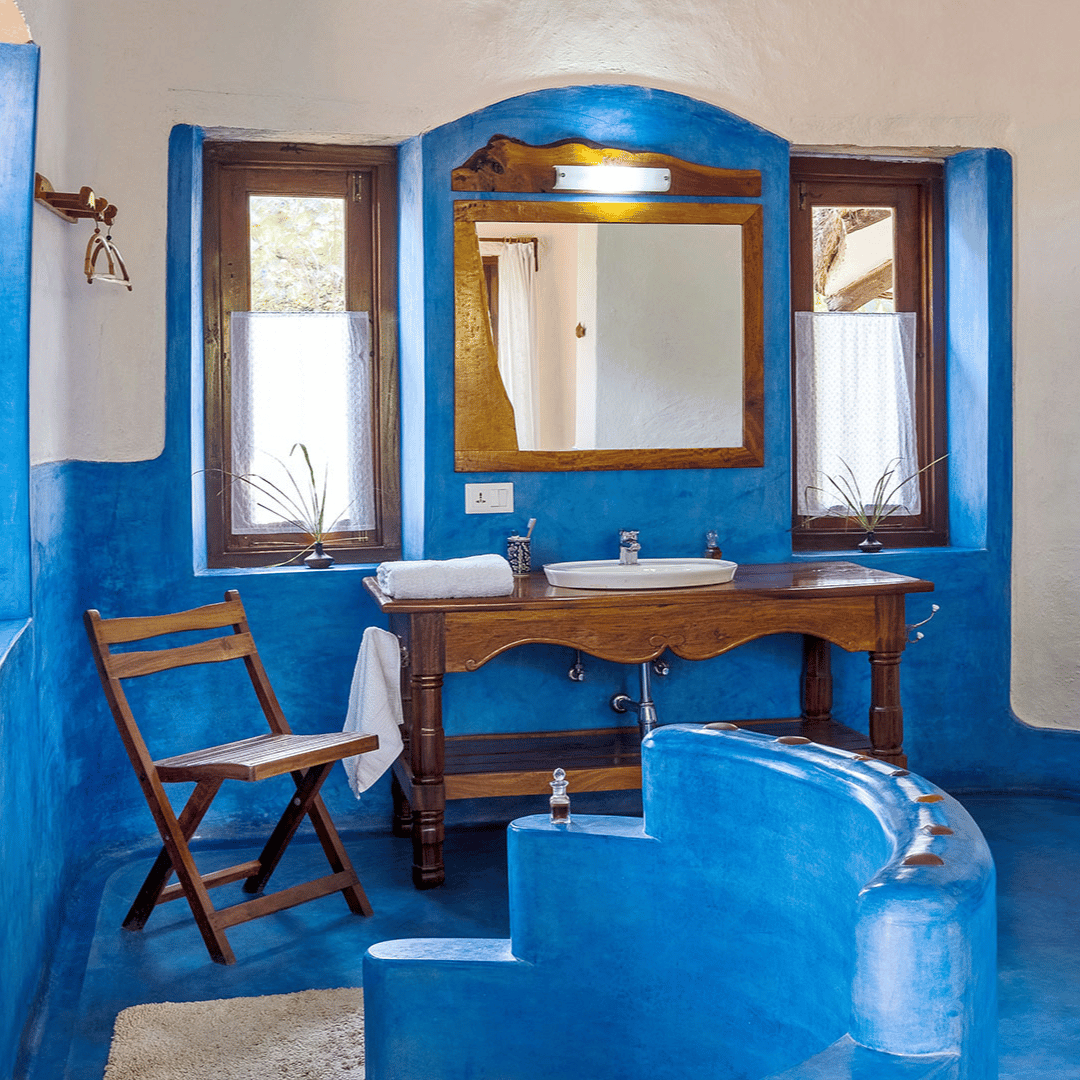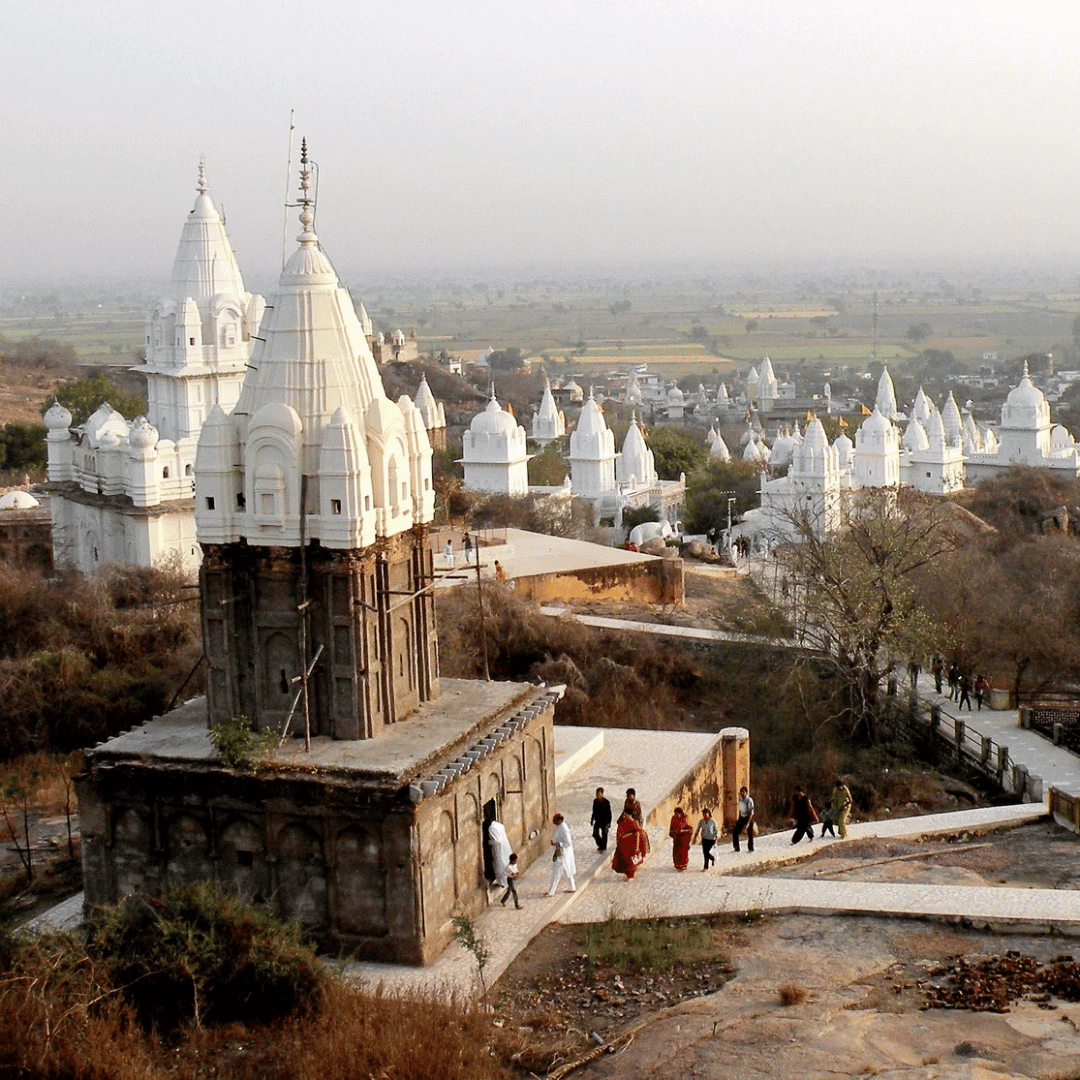Highlights of India Tour Itinerary
-
Delhi, India’s lively and layered capital, is a city that encapsulates the vast sweep of the country’s history and diversity. With a population exceeding 12 million, it’s a sprawling metropolis that has served as the seat of empires, the heart of colonial rule, and now the political and administrative hub of independent India. The city is often described as two distinct parts: Old Delhi, with its maze of narrow laneways, centuries-old mosques and bustling bazaars; and New Delhi, planned by the British in the early 20th century, characterised by wide boulevards, formal gardens and stately colonial architecture.
Delhi has been built, destroyed and rebuilt many times over the centuries, and each era has left its mark - from the Qutub Minar and Humayun’s Tomb to the Jama Masjid and Lutyens’ Delhi. It's a city where ancient ruins stand in the shadow of glass-and-steel buildings, and where food stalls, designer boutiques, temples and traffic all jostle for space.
On arrival at Delhi airport, you’ll be welcomed in traditional Indian style before being transferred to your hotel. Depending on your arrival time, you might wish to take a short walk or enjoy a quiet evening meal at your accommodation. Tomorrow you'll begin to explore this multifaceted capital in more detail, but for now, it’s time to settle in and rest after your journey. Overnight in Delhi.
-
Delhi is a city that rewards curiosity, revealing its layers slowly through its streets, monuments, food, and people. With over a thousand years of continuous settlement, it has been shaped by dynasties, conquerors, saints and revolutionaries. Now a vast metropolis, Delhi brings together the past and present in unexpected ways - where a Mughal tomb might stand beside a modern art gallery, or an ancient stepwell is tucked away behind a bustling market.
Old Delhi is a maze of history and living tradition. Begin your day immersed in its atmosphere by exploring Jama Masjid, a vast 17th-century mosque built by Shah Jahan. From its wide sandstone steps, you can take in views of the old city’s domes and minarets. A rickshaw ride through Chandni Chowk brings you into the heart of the city’s oldest market area, where silver merchants, spice vendors, sweet shops and traditional medicine stalls compete for space and attention. The experience is a sensory one: fragrant, noisy, colourful, and entirely unforgettable. A visit to Raj Ghat nearby offers a quiet pause, with its black marble platform marking the site of Mahatma Gandhi’s cremation.
Crossing into New Delhi, the contrast is striking. Wide, tree-lined avenues laid out by the British in the 1920s frame some of the capital’s most iconic institutions. Take a drive past India Gate, built to honour Indian soldiers who died in World War I, and continue to Rashtrapati Bhavan and Parliament House - architectural reminders of colonial ambition and the seat of independent India’s governance.
Among Delhi’s many cultural attractions, Humayun’s Tomb stands out for its elegance and influence. Built in the 16th century, it was the first garden tomb in India and provided inspiration for the design of the Taj Mahal. Equally impressive is Qutub Minar, a 72-metre-high minaret that rises from a complex of ruins dating back to the founding of Delhi’s first Muslim kingdom.
Those drawn to the arts might spend time at the National Museum, with its collection of ancient artefacts and textiles, or visit the Gandhi Smriti, located in the house where Gandhi spent his final days. The Crafts Museum showcases the diversity of India’s handmade traditions, with displays of weaving, pottery, and folk art.
If shopping is on your radar, head to Dilli Haat for handicrafts and regional street food, or explore the boutiques and cafés of Hauz Khas Village, where old Mughal ruins sit alongside designer studios and art galleries.
Whatever your interests, Delhi is a city that invites exploration. With the help of a local guide, your time here can be tailored to your pace and preferences - ensuring you experience both the highlights and the hidden gems of this endlessly fascinating capital.
-
This morning, depart Delhi and begin your journey to Agra, a drive of around four hours through the plains of northern India. As you leave the capital behind, the landscape shifts to a more rural setting, with fields, small towns, and roadside stalls offering a glimpse of everyday life in the countryside. On arrival in Agra, check in to your hotel and take some time to settle in before heading out to explore one of the city’s most important landmarks.
In the afternoon, visit the impressive Agra Fort, a UNESCO World Heritage Site and a key monument of the Mughal era. Built primarily by Emperor Akbar in the late 16th century and later expanded by his grandson Shah Jahan, the fort is a sprawling complex of red sandstone walls enclosing palaces, audience halls, gardens and mosques. As you explore its many courtyards and chambers, your guide will share stories of the emperors who lived here and the events that shaped the Mughal Empire.
From various vantage points within the fort, you’ll enjoy striking views of the nearby Taj Mahal across the Yamuna River - especially poignant when you learn that Shah Jahan was later imprisoned here by his son and is said to have spent his final years gazing at the mausoleum he built for his beloved wife. The fort is a masterpiece of design, blending Persian and Indian styles, and offers a fascinating introduction to the grandeur and intrigue of Mughal Agra.
-
Rise early this morning for a dawn visit to the Taj Mahal, one of the world’s most celebrated monuments and an enduring symbol of love and devotion. Accompanied by your local guide, you’ll arrive in the soft early light, before the crowds gather, when the monument is arguably at its most enchanting. Commissioned in 1632 by Mughal Emperor Shah Jahan in memory of his beloved wife Mumtaz Mahal, this ivory-white marble mausoleum is as much an architectural marvel as it is a deeply emotional experience. As the rising sun casts golden and pink hues over its surface, your guide will share stories of its creation, symbolism and the human saga behind it.
Return to your hotel for breakfast, then check out and begin your journey westward toward Jaipur. Along the way, stop to explore Fatehpur Sikri, the fascinating red sandstone city built by Emperor Akbar in the 16th century. Once the capital of the Mughal Empire, it was abandoned just a few years after its completion, likely due to water shortages. Today, its impressive palaces, mosques and audience halls remain remarkably intact, offering insight into Akbar’s court and his vision for a tolerant and unified empire.
After visiting Fatehpur Sikri, continue the drive to Jaipur, the capital of Rajasthan, which takes around four hours. Known as the "Pink City" for the distinctive colour of its old city buildings, Jaipur is a place of rich history, vibrant culture and architectural elegance. It’s the first planned city of India, laid out in the 18th century according to ancient Vedic design principles, and remains one of the most accessible and engaging cities in the country.
Upon arrival in Jaipur, check in to your hotel. Many visitors choose to stay in one of Jaipur’s beautifully restored heritage properties, which often feature traditional Rajasthani decor, peaceful courtyards, and even swimming pools, perfect for a refreshing dip after a day of travel.
The rest of the afternoon is free for you to enjoy at your own pace. You may wish to take a leisurely wander through the old walled city, where you’ll find bustling bazaars, narrow laneways and a riot of colour and energy. Local markets offer everything from textiles and silver jewellery to hand-block printed fabrics and spices - and a bit of friendly bargaining is all part of the fun. Alternatively, you might prefer to unwind at your hotel, enjoy a cool drink in a shaded garden, or simply take in the rhythm of the city from a quiet verandah.
-
Today is set aside for a full day of sightseeing in Jaipur with an expert local guide, who will help tailor the experience to suit your interests and pace. Known as the “Pink City” thanks to the distinctive colour of its old buildings, Jaipur is a treasure trove of history, architecture and culture - and one of India’s most engaging destinations. Whether you’re drawn to grand forts, intricate palaces, bustling markets or traditional arts, there’s something here to captivate every traveller.
A visit to Amber Fort is a highlight for most. Perched on a hilltop just outside the city, this 16th-century fortress was once the capital of the Kachwaha Rajputs and is a stunning example of Rajput and Mughal architecture. Explore its ornate courtyards, mirror-tiled halls and intricate frescoes while learning about the royal dynasties who once ruled here. The views from the fort over the surrounding countryside are also superb.
Back in the city, the City Palace complex is another must-see. Still partially home to the royal family, it houses a museum filled with artefacts such as royal garments, miniature paintings, weapons and ceremonial items. The palace architecture reflects a blend of Rajasthani and Mughal styles, and the beautifully maintained courtyards and gateways offer plenty to explore.
Nearby, don’t miss the Jantar Mantar - a UNESCO World Heritage Site and one of the most remarkable observatories in the world. Built by Maharaja Sawai Jai Singh II in the 18th century, the site features a collection of massive astronomical instruments, including the world’s largest stone sundial, all still astonishingly accurate.
Other worthwhile stops might include the Hawa Mahal, or Palace of Winds, a five-storey pink sandstone facade with hundreds of tiny windows designed to allow royal women to observe life on the street below. The Albert Hall Museum in Ram Niwas Garden houses a collection of artefacts and decorative arts, while the Galtaji Temple (Monkey Temple), set in a rocky valley, provides a more spiritual experience.
If time and interest allow, you may also visit a local artisan studio to learn about traditional crafts such as block printing, gemstone cutting or miniature painting - all art forms for which Jaipur is renowned.
-
This morning, depart Jaipur and enjoy a scenic three-hour drive through the arid plains and low hills of Rajasthan to the small town of Pushkar. Unlike many of Rajasthan’s bustling cities, Pushkar has a quieter, more relaxed atmosphere and is known for its spiritual significance, sacred lake, and distinctive charm. Upon arrival, you’ll check in to your hotel and take some time to refresh before setting out to explore with a local guide.
In the afternoon, enjoy a gentle walking tour of Pushkar, which is best discovered on foot. The town is centred around a sacred lake said to have formed when Lord Brahma, the creator god in Hinduism, dropped a lotus flower to the earth. As a result, Pushkar is considered one of the holiest towns in India, and it draws pilgrims year-round. With your guide, you’ll wander the narrow streets lined with vibrant shops, modest temples, and rooftop cafés. The pace is unhurried, the people friendly, and the setting picturesque.
Pushkar is also one of the few places in the world with a temple dedicated to Brahma, and your guide may take you there, depending on interest. As the late afternoon light softens, make your way to the ghats - the stone steps that line the lake - where pilgrims gather to offer prayers, bathe in the sacred waters, and participate in simple evening rituals. It’s a peaceful and photogenic spot to spend time as the sun sets.
You may choose to linger along the lakeside, enjoy a cup of masala chai from a local stall, or return to your hotel for a quiet evening. Pushkar has a uniquely calm rhythm, offering a nice contrast to the busier cities on your journey - an ideal place to unwind and take in the spiritual and cultural fabric of rural Rajasthan.
-
After breakfast, depart Pushkar and begin the drive to Udaipur, a journey of approximately five hours through changing Rajasthani landscapes. As the desert terrain gradually gives way to rolling hills and scattered greenery, you'll approach the Aravalli Range - one of the oldest mountain ranges in India - which frames the setting for one of the country’s most romantic and visually striking cities.
Often referred to as the ‘City of Lakes’, Udaipur is built around a series of man-made lakes and is best known for its refined palaces, whitewashed havelis, and serene setting. It was founded in 1559 by Maharana Udai Singh II as the new capital of the Mewar kingdom, after the older capital of Chittorgarh was deemed too vulnerable to attack. Protected by the surrounding hills and set beside the shimmering waters of Lake Pichola, Udaipur was both defensible and beautiful, and it soon flourished as a centre of art, culture, and architecture.
Today, the city retains much of its historical character and continues to be shaped by its royal heritage. Its skyline is dominated by domes and turrets, while its streets hum with the rhythm of traditional crafts, local markets, and a gentle pace of life that contrasts with the busier cities of northern India.
On arrival, check in to your hotel and take some time to rest or freshen up. As evening falls, head out to one of Udaipur’s lakeside restaurants - many of which offer panoramic views of the water, often with the City Palace or the famous Lake Palace as a dramatic backdrop. This is a lovely time to unwind, enjoy a leisurely meal, and take in the beauty of the city as the buildings glow in the warm evening light and reflect on the still surface of the lake.
-
After breakfast, set out to explore Udaipur with a local guide - a city often considered one of the most graceful in India. Known for its lakeside setting, romantic architecture and regal history, Udaipur offers a blend of cultural richness and scenic beauty that makes it a favourite for many travellers.
Begin with a visit to the City Palace, the largest in Rajasthan. This sprawling complex of interconnected palaces, courtyards, balconies and towers was built over several centuries by successive rulers of the Mewar dynasty. Overlooking Lake Pichola, the palace combines elements of Rajput and Mughal architecture, and offers sweeping views of the city and the surrounding hills. Highlights within the palace include Mor Chowk (Peacock Courtyard), with its intricate mosaic work, and the Crystal Gallery, home to a remarkable collection of 19th-century furniture and décor.
From here, walk a short distance to Jagdish Temple, an active Hindu temple dedicated to Lord Vishnu. Built in 1651, it features intricately carved pillars, a steep flight of steps and a richly decorated shikhara (tower). It’s a vibrant place of worship, often filled with the sounds of ringing bells and chanting.
Next, visit the Bharatiya Lok Kala Mandal, a local folk art museum that provides insight into the region’s traditional culture. The museum showcases puppets, tribal costumes, musical instruments and rural artworks, and often includes short puppet performances that are especially enjoyable for younger visitors or those interested in India’s storytelling traditions.
Later in the afternoon, take a relaxing boat cruise on Lake Pichola, one of Udaipur’s most iconic experiences. As you glide across the still waters, you’ll pass elegant ghats, lakeside havelis, and the magnificent Lake Palace - once the summer residence of the Mewar rulers and now a luxury hotel. The boat may also stop at Jag Mandir, a small island palace with a quiet courtyard, shady trees and beautiful views of the City Palace from across the water.
As the sun sets and the buildings around the lake begin to glow in the golden light, it’s easy to understand why Udaipur is often called the 'Venice of the East'. Return to your hotel or stay out a little longer to enjoy dinner at one of the city’s rooftop or lakeside restaurants, where the ambience and scenery are hard to beat.
-
This morning, you’ll be transferred to the airport for your flight to Mumbai, India’s largest and most cosmopolitan city. Formerly known as Bombay, this bustling metropolis is a dynamic blend of tradition and modernity. Home to colonial-era landmarks, glittering skyscrapers, street food stalls and thriving art scenes, Mumbai is also the heart of India’s film industry, Bollywood.
On arrival at Chhatrapati Shivaji Maharaj International Airport, you’ll be met by a local representative and transferred to your hotel. The journey into the city reveals a glimpse of Mumbai’s unique personality - where sleek high-rises overlook fishing villages, and tuk-tuks whizz past British-era buildings, all set against the backdrop of the Arabian Sea.
Depending on your arrival time, the rest of the day is free for you to settle in and take things at your own pace. You might choose to unwind at your hotel or step out for a walk through the local neighbourhood to get a feel for the city’s rhythm. Many of Mumbai’s best experiences begin simply with a cup of chai at a street-side stall or a stroll along Marine Drive, where locals gather each evening to enjoy the breeze and sunset.
If you’re feeling adventurous, your hotel concierge can recommend nearby cafes or restaurants to sample the city’s renowned cuisine - from traditional Maharashtrian dishes to global flavours. Whether you’re relaxing or ready to dive into the buzz of Mumbai, the city’s energy is infectious, and your time here promises a fascinating contrast to the places you’ve already visited.
-
Today you’ll spend a full day exploring the vibrant and fast-paced city of Mumbai with an expert local guide. A place of striking contrasts, Mumbai is India’s financial powerhouse, home to Bollywood and one of the country’s most stylish cities - yet also layered with colonial history, spiritual landmarks and traditional neighbourhoods.
Begin your day with a guided city tour that introduces you to some of Mumbai’s best-known landmarks. Start at the Gateway of India, the city’s iconic arch overlooking the Arabian Sea, built in 1924 to commemorate the visit of King George V. From here, take in the view of the majestic Taj Mahal Palace Hotel before continuing along Marine Drive - known as the ‘Queen’s Necklace’ for its sweeping curve and glittering night-time lights - to the historic district of Fort. This area is filled with striking colonial-era buildings, including the Gothic-style Chhatrapati Shivaji Maharaj Terminus (formerly Victoria Terminus), a UNESCO World Heritage Site.
You might also visit Mani Bhavan, once the Mumbai base of Mahatma Gandhi and now a museum dedicated to his life and work, or take a detour through Dhobi Ghat, the world’s largest open-air laundry. It’s a fascinating glimpse into an industry that has thrived for generations and remains a vital part of the city.
In the afternoon, take a short ferry ride from the Gateway of India to visit the Elephanta Caves, located on a forested island about 10km offshore. A UNESCO World Heritage Site, the caves house ancient rock-cut temples dating back to the 5th to 7th centuries. The main cave is dedicated to Lord Shiva and features an impressive sculpture of the deity in his three-headed form, representing creator, protector and destroyer.
Later in the day, return to the city for a bit of shopping. Mumbai is a great place to pick up everything from designer fashion and contemporary Indian labels to local crafts, jewellery and antiques. For high-end shopping, head to Colaba Causeway or the boutiques around Kala Ghoda and Bandra. If you're in the mood for a market atmosphere, explore Crawford Market or the bustling lanes of Chor Bazaar.
As evening sets in, you might want to soak up the buzz of the city with dinner or a drink at one of Mumbai’s many excellent restaurants or rooftop bars. From fine dining to street food, the city’s culinary scene is as diverse as its people - offering the perfect way to wind down after a day of discovery.
-
This morning, transfer to the airport for your flight to Chennai, the capital of Tamil Nadu and a major cultural and historical hub of South India. On arrival, you’ll be met by a local representative and begin the two-hour drive south along the scenic Coromandel Coast to Mahabalipuram (also known as Mamallapuram), a small but historically significant coastal town renowned for its ancient stone carvings and temples.
Once a thriving port city under the Pallava dynasty in the 7th and 8th centuries, Mahabalipuram was a centre of art, architecture and maritime trade. Today, it is best known for its group of UNESCO World Heritage-listed monuments - an extraordinary collection of rock-cut caves, sculpted reliefs and freestanding temples that reflect a golden age of Dravidian architecture.
Later in the afternoon, meet your local guide and set out to explore these remarkable archaeological treasures. One of the highlights is Arjuna’s Penance, a massive bas-relief carved into a granite cliff face that stretches for 27 metres in length and more than 9 metres in height. The intricate scene - believed to depict either the story of Arjuna’s austerities or the descent of the Ganges - features hundreds of figures including gods, animals, sages and celestial beings, all rendered with incredible detail and expression.
You’ll also visit the Five Rathas, a group of monolithic shrines each carved from a single piece of stone, and the Shore Temple, a striking structure set dramatically against the Bay of Bengal. Dedicated to Shiva and Vishnu, the temple’s sculpted walls are adorned with images of gods and animals, and its silhouette at sunset is one of the most photographed in southern India.
The town itself has a laid-back feel, with sandy streets, open-air cafes and artisans selling locally made stone carvings, a tradition that continues to this day. As the sun begins to lower over the coast, you may wish to take a short walk along the beach or simply relax and enjoy the coastal setting before returning to your hotel for the evening.
-
Enjoy a leisurely start to the day in Mahabalipuram. If you're staying near the beach or in a property with a pool, take the opportunity for a refreshing morning swim before breakfast. The early hours are especially pleasant along the coast, with cooler air, soft light, and the rhythmic sound of the Bay of Bengal providing a calming backdrop.
After checking out, depart Mahabalipuram for the drive to Tanjore (also known as Thanjavur), a journey of approximately five hours through the varied landscapes of Tamil Nadu. Along the way, you’ll pass small towns, rice paddies, coconut groves, and clusters of roadside temples - glimpses of daily life in southern India unfolding outside your window.
Tanjore, once the heart of the powerful Chola Empire, is a city steeped in cultural and religious history. It is widely regarded as a cradle of Tamil art, classical music, and temple architecture. The Cholas, who ruled from the 9th to the 13th centuries, left behind a legacy of grand temples and bronze sculpture that still define the region today.
On arrival, check in to your hotel and take some time to relax. Many of the properties here are set within peaceful grounds, often surrounded by palm trees and tropical gardens. If you're staying somewhere with a pool - as many hotels in the region offer - it’s a great time to take a dip and cool off after your travels. With the evening at leisure, you might like to enjoy dinner on-site or take a gentle walk around the hotel gardens as the day winds down.
-
This morning, if time permits and you're feeling energetic, you may like to visit the magnificent Brihadeeswara Temple before departing Tanjore. Also known as the Big Temple, this UNESCO World Heritage Site is one of the finest examples of Chola architecture and a masterpiece of Tamil temple design. Built in the early 11th century by King Raja Raja Chola I, the temple is dedicated to Lord Shiva and features a towering 60-metre high vimana (sanctum tower), intricately carved sculptures, and a massive Nandi bull carved from a single block of stone. Visiting in the early morning, when the temple is bathed in soft light and fewer visitors are around, offers a peaceful and atmospheric experience.
After returning to your hotel for breakfast and check-out, begin the four-hour drive south to Madurai. The route takes you through the fertile plains of Tamil Nadu, past fields of sugarcane, banana plantations, and small farming villages. Along the way, you may notice roadside shrines, colourful temple towers, and plenty of local life - all adding to the texture of your journey.
Arrive in Madurai in the early afternoon. One of the oldest continuously inhabited cities in India, Madurai is often referred to as the cultural capital of Tamil Nadu. It has long been a centre for learning, literature, and devotion, particularly to the goddess Meenakshi, who is enshrined in the city’s most famous landmark, the Meenakshi Amman Temple.
The cityscape is dominated by this grand temple complex, with its striking gopurams (gateway towers) rising high above the surrounding buildings. Covered in a riot of colourful carvings depicting gods, goddesses, animals and mythical creatures, these towers are as visually impressive as they are spiritually significant. The temple serves not only as a place of worship but also as the social and cultural heart of Madurai - a constant hum of activity, music, prayer and ceremony.
After checking in to your hotel, the remainder of the afternoon is free for you to relax, explore the area around your accommodation, or enjoy a cup of South Indian filter coffee in a local café while taking in the lively pace of the city.
-
Today you’ll enjoy a full day of sightseeing in Madurai with a knowledgeable local guide, giving you a chance to explore the city’s deep historical roots, vibrant markets, and spiritual traditions. Known for its ancient past, Madurai has been a centre of Tamil culture and learning for over two millennia. With its mix of temples, colonial architecture and bustling street life, the city offers a rich and immersive experience.
Begin your day with a visit to the Meenakshi Amman Temple, the spiritual and cultural heart of Madurai. This sprawling complex is dedicated to Meenakshi, a form of the goddess Parvati, and her consort Sundareswarar (Lord Shiva). The temple is a marvel of South Indian architecture, with its towering gopurams (gateway towers) covered in thousands of colourful sculptures. Inside, the temple is a hive of activity - priests conducting rituals, devotees making offerings, and pilgrims paying their respects. Your guide will help you understand the symbolism and stories behind the temple’s many shrines and halls, including the Thousand Pillar Hall, which is famed for its intricate stone carvings and musical pillars.
Next, visit the Gandhi Memorial Museum, housed in the 17th-century Tamukkam Palace. The museum chronicles India’s independence movement and Mahatma Gandhi’s pivotal role in it, with a particular focus on his connection to Tamil Nadu. Among its most moving exhibits is a blood-stained cloth said to be from the garments Gandhi was wearing at the time of his assassination.
Continue on to the Thirumalai Nayak Palace, an architectural blend of Dravidian and Islamic styles. Built in the 17th century by King Thirumalai Nayak, the palace is known for its impressive domes, arches, and columned courtyards. Though only part of the original structure survives, it still offers a glimpse into the opulence of the Nayak dynasty.
Later, your guide will take you through some of Madurai’s lively markets. The tailor’s market is a fascinating stop - Madurai is known for its high-quality cotton fabrics, and tailors here can whip up made-to-measure garments at impressive speed. The bustling fruit and vegetable market is equally colourful and chaotic, filled with stalls piled high with bananas, mangoes, chillies, okra and more. It’s a great place to interact with locals, sample a few snacks, and soak up the city’s everyday rhythm.
If time allows, you might also enjoy visiting a local flower market or stopping by one of the city’s famous sweet shops to try a piece of Madurai’s much-loved jigarthanda - a chilled drink-dessert that almost tastes like an almond milkshake, perfect on a warm day.
-
Set off early this morning for the long but rewarding drive from Madurai to Kanyakumari, a journey of around six hours that takes you through the southern reaches of Tamil Nadu. The scenery changes as you travel: from agricultural plains and small villages to the drier, rockier landscapes near the southern coast, where wind turbines often dot the horizon.
Kanyakumari, the southernmost tip of the Indian subcontinent, holds both geographical and cultural significance. It is the point where the Bay of Bengal, the Arabian Sea and the Indian Ocean converge - a place long associated with mythology, pilgrimage and maritime history. For many Indians, it is a deeply spiritual location and a symbolic ‘end of the land’. On arrival, enjoy lunch at a seaside restaurant, with views of the ocean stretching out in all directions.
If time permits, take a short stroll along the promenade or visit the Vivekananda Rock Memorial, a short boat ride offshore. This small island features a monument dedicated to Swami Vivekananda, a revered Hindu monk and philosopher who meditated here in the 1890s. From this vantage point, you’ll also have panoramic views of the coast and the Thiruvalluvar Statue, an enormous stone figure honouring the famed Tamil poet and philosopher.
After lunch, continue your journey into the state of Kerala, arriving in the beachside town of Kovalam by late afternoon. Known for its golden sand, swaying coconut palms and relaxed atmosphere, Kovalam was once a sleepy fishing village before becoming a popular destination for both local and international visitors.
Settle into your accommodation and, if you wish, head out for a gentle stroll along the beach as the sun dips into the Arabian Sea. The sunsets here are often spectacular, casting a warm glow over the shoreline and offering a peaceful close to a full day of travel.
-
Today is yours to enjoy at leisure in Kovalam, one of Kerala’s most popular and picturesque coastal towns. Nestled along the Arabian Sea, Kovalam is known for its sweeping crescent-shaped beaches, calm waters, and laid-back atmosphere. It’s the ideal spot to slow down, recharge and soak up a different side of India after your journey through the temples and cities of the north and south.
Spend your morning strolling along the soft sands of Lighthouse Beach, the most well-known of Kovalam’s three main beaches. You might like to climb the red-and-white striped lighthouse at the southern end for panoramic views of the coastline and inland coconut groves. The early hours are particularly peaceful, with fishermen hauling in their nets and beachside cafés beginning to stir.
For those seeking relaxation and rejuvenation, this is an excellent place to experience an Ayurvedic massage or treatment. Kerala is renowned for its Ayurvedic heritage, and many reputable centres in Kovalam offer massages, herbal therapies and wellness consultations tailored to your needs. A gentle abhyanga massage with warm oil or a shirodhara treatment - where oil is poured in a steady stream across the forehead - can be a deeply calming experience.
You may also want to explore the quieter neighbouring beaches of Hawa Beach or Samudra Beach, which offer a more local vibe and fewer crowds. If you're up for a short excursion, local tuk-tuks or drivers can take you to nearby fishing villages or to visit temples and craft markets in the area.
Back in town, browse small boutiques selling handmade crafts, spices, sarongs and silver jewellery. Come sunset, settle in at a beachside café or restaurant and enjoy a meal of freshly caught seafood - grilled prawns, fish curry or the local favourite, Karimeen Pollichathu (pearl spot fish cooked in banana leaf). The view of the sun dipping into the Arabian Sea, with the sky painted in warm hues, is a highlight of any stay in Kovalam.
Whether you choose to indulge in a spa treatment, explore the coastline, or simply stretch out with a good book and a sea breeze, today offers the perfect chance to unwind and experience Kerala’s coastal charm.
-
This morning, depart Kovalam and make your way north through Kerala’s scenic heartland. En route to Thottappally, stop to visit the charming Krishnapuram Palace - a lesser-known gem that offers a glimpse into the region’s rich cultural and architectural heritage. Built in the 18th century by the Travancore king Marthanda Varma, the palace is a fine example of traditional Kerala architecture, with its gabled roofs, narrow corridors and inner courtyards. Inside, you’ll find an impressive collection of antique furniture, bronze statues, and one of the largest murals in Kerala, the exquisite Gajendra Moksham, which depicts a scene from Hindu mythology.
After your visit, continue on to the village of Thottappally, where the pace of life slows and the palm-lined backwaters come into view. Here, you’ll board your private, fully air-conditioned houseboat - a modern take on the traditional kettuvallam, once used to transport rice and spices across Kerala’s waterways. These comfortable boats are designed for a relaxed and immersive experience, with well-appointed cabins, en suite bathrooms, and a shaded lounge area for watching the world go by.
As you begin your gentle afternoon cruise along Kerala’s famed backwaters, you’ll drift past emerald rice paddies, coconut plantations, and quiet villages where life moves to the rhythm of the water. Children wave from the banks, fishermen tend to their nets, and women wash clothes in the canals, each offering a window into everyday life in this unique ecosystem.
On board, your three dedicated crew members - typically a captain, chef and attendant - will take care of everything, from navigating the narrow canals to preparing delicious Keralan meals. Using fresh local ingredients, lunch and dinner are lovingly cooked on board, often featuring the catch of the day, seasonal vegetables, and regional specialities such as fish moilee or avial.
As the sun sets over the water, the light softens and the air cools. Your boat will moor for the night in a quiet spot along the waterway, allowing you to enjoy the peaceful atmosphere of rural Kerala after dark. This overnight stay on the houseboat is often a highlight of any journey through the south - a rare chance to slow down, unwind and experience the serene beauty of Kerala’s backwaters in complete comfort.
-
This morning, enjoy a leisurely breakfast on board your houseboat as it makes its way to Alleppey, also known as Alappuzha - the gateway to Kerala’s backwaters. Often referred to as the "Venice of the East" for its network of canals and lagoons, Alleppey is a key hub of the region’s inland water transport and the starting point for many backwater journeys.
On arrival, disembark and take a short transfer by road and boat to your accommodation - a carefully selected guest house or homestay tucked away along one of the smaller canals, where peace and privacy go hand in hand with local character. This part of Kerala is known for its intimate and authentic hospitality, and there’s a range of accommodation options to suit all styles and budgets. Whether you're after a simple home-cooked experience with a welcoming family, or a boutique riverside retreat with hammocks, gardens and open verandahs, we’ll ensure you’re placed somewhere that feels right for you.
These hidden-away spots offer a completely different pace of life. The afternoon is yours to unwind and settle in. You might like to take a walk through the village paths, chat with your hosts over a cup of chai, or simply relax by the water’s edge as houseboats and canoes glide past. Some properties offer activities such as cooking classes, guided walks through the paddy fields, or canoe rides at sunset. These can easily be arranged through your hosts if you’re keen to explore further.
The sounds of birdsong, rustling palms and the occasional splash from the water create a rhythm that is wonderfully calming. This is a place to breathe deeply, slow down, and enjoy the gentle beauty of Kerala’s backwater life, far removed from the noise and bustle of the cities. In the evening, a home-cooked Keralan meal, often featuring fresh fish, coconut and spices, is the perfect way to end the day.
-
Today is yours to enjoy at your own pace in Alleppey, where life is closely tied to the rhythm of the backwaters. Whether you're feeling energetic or simply want to slow down, there are plenty of ways to spend your time in this peaceful corner of Kerala.
Start the day with a stroll through the nearby village, where you can observe daily life as locals tend to their gardens, prepare food, or ferry supplies by canoe. Walking along the narrow pathways that weave between paddy fields and canals gives you a deeper appreciation for the region's close-knit communities and their deep connection to the land and water.
If you're interested in local traditions, consider taking a cooking class with your hosts or a nearby home cook. Learn how to prepare classic Keralan dishes such as fish moilee, vegetable thoran, or appam with stew, using fresh spices, coconut and seasonal produce. It's a hands-on way to engage with the local culture, and of course, you'll get to enjoy the results of your efforts.
You might also like to visit a nearby cottage industry workshop, such as a coir-making unit where artisans transform coconut husk fibres into ropes, mats and brushes using age-old techniques. These small-scale industries are an important part of the region’s economy and offer insight into Kerala’s resourceful craftsmanship.
For a slower afternoon, relax on your guest house verandah with a good book, or enjoy a canoe ride through the smaller canals. These narrow waterways are too tight for houseboats, and offer a more intimate look at village life and birdlife. Keep an eye out for kingfishers, egrets, and cormorants, or just let the quiet water carry you along.
Alleppey invites you to do as much or as little as you like. Whether you're engaging with locals, trying your hand at cooking, or simply soaking in the scenery, your time here offers a meaningful pause in your journey through India.
-
This morning, set off on a relaxed two-hour drive from Alleppey to Cochin (also known as Kochi), a coastal city that has long been a meeting point of cultures, traders and travellers. Your destination is Fort Kochi, the historic heart of the city, where the colonial past is beautifully preserved and the atmosphere is distinctly laid-back.
On arrival, check in to your hotel, which will be located within the charming precincts of Fort Kochi. This area is an ideal base for exploring the city: a peaceful enclave of leafy lanes, heritage buildings and waterside promenades. The architecture here reflects the city’s layered history, with Portuguese, Dutch and British influences visible in everything from churches and warehouses to former homes now converted into boutique hotels and cafés.
After settling in, enjoy a leisurely afternoon stroll through the neighbourhood. You might wander past St Francis Church - the oldest European church in India - or visit the Dutch Cemetery, shaded by old trees and filled with worn tombstones that speak to the area’s long maritime history. Along the waterfront, stop to see the iconic Chinese fishing nets in action, as their cantilevered frames and rhythmic motion are a signature sight of Kochi. This is also a lovely spot to pause for afternoon tea or a cold drink at one of the restored colonial-era cafés, where you can watch the ships come and go across the harbour.
In the evening, attend a traditional Kathakali performance, one of Kerala’s most striking classical art forms. This highly stylised dance-drama combines elaborate costume, intricate facial makeup, expressive hand gestures and powerful storytelling to bring to life stories drawn from Indian mythology. Often beginning with the performers applying their makeup on stage - a ritual in itself - the performance builds into a dramatic and expressive display of movement, rhythm and emotion. With its rich cultural significance and mesmerising presentation, Kathakali offers a truly memorable introduction to Kerala’s artistic heritage.
After the performance, you may like to dine at one of Fort Kochi’s many excellent restaurants, where you can enjoy a blend of Keralan flavours and international influences - a fitting end to your first evening in this historic port city.
-
Today you’ll enjoy a full day of sightseeing in Cochin with a local guide, uncovering the city’s unique blend of cultures, religions and colonial influences. As one of India’s most historically layered cities, Cochin (or Kochi) offers much more than just its well-known landmarks - and your guide will help you discover both the iconic sites and the hidden corners that give the city its charm.
Begin the day with a visit to the Chinese fishing nets along the Fort Kochi shoreline. These towering timber-and-rope structures, operated by teams of fishermen, are thought to have been introduced by Chinese traders from the court of Kublai Khan in the 14th century. Watching the fishermen lower and raise the nets using a traditional counterweight system is a fascinating glimpse into a centuries-old livelihood that still survives today.
Next, explore St Francis Church, the oldest European church in India. Built by the Portuguese in the early 1500s, this simple, whitewashed building holds great historical importance. It was once the resting place of explorer Vasco da Gama, and its understated beauty speaks to its long and varied history under Portuguese, Dutch and British control.
Continue on to Mattancherry to visit the Dutch Palace, also known as the Mattancherry Palace. While its exterior is modest, the interior is adorned with exquisite murals that depict stories from Hindu epics such as the Ramayana and Mahabharata. The palace also contains fascinating artefacts related to the Cochin royal family and Kerala’s history under European influence.
Just a short walk away lies the Pardesi Synagogue, built in 1568 and still in use today. It’s the oldest active synagogue in the Commonwealth and is located in the heart of Jew Town, once the hub of the city’s Jewish community. Inside, admire the hand-painted Chinese tiles, crystal chandeliers and ancient scrolls. Your guide will share insights into the Jewish presence in Kerala, which dates back over a thousand years.
After visiting the synagogue, take some time to browse the antique and curio shops that line the narrow streets of Jew Town. Here you’ll find everything from carved wooden furniture and spice boxes to brass lamps, vintage maps and colourful textiles. Even if you’re not shopping, it’s an atmospheric place to wander and take in the scent of cardamom and cinnamon drifting from nearby spice stores.
Depending on your interests, your guide may also take you to explore some of Fort Kochi’s lesser-known sights. You might stop at the Indo-Portuguese Museum, which showcases artefacts from Cochin’s Christian heritage, or the Maritime Museum, where you can learn about Kochi’s naval history. Art lovers may enjoy a visit to the Kashi Art Café, an institution in Fort Kochi’s contemporary arts scene, where exhibitions by local and international artists are frequently on display.
If time permits, you could also explore the nearby village of Kumbalangi, a model eco-tourism destination where traditional practices like coir-making, crab farming and Chinese net fishing are demonstrated by locals. It offers a peaceful and authentic look at rural life just beyond the city.
-
This morning, after breakfast and check-out, you’ll be transferred to Cochin International Airport for your onward journey. Whether you're heading home or continuing your travels elsewhere in India, your driver will ensure you arrive at the airport in good time for your flight. Safe travels!
The India Unbound Difference
At India Unbound, we’ve spent twenty years on the ground in India, learning all about its intricacies, landscapes and cultures. We use this first-hand knowledge to carefully curate travel itineraries for our guests, and are proud to be a reputable private touring specialist. In addition, our team of local partners offer guarantees of punctuality, quality and service. All of our India private tour itineraries include all accommodation mentioned, daily breakfasts and other meals as specified, all transfers, touring and sightseeing by air-conditioned Toyota Innova or similar vehicle, and internal flights as outlined in the itinerary. Private activities and sightseeing with English-speaking local guides are included, along with entrance fees, drinking water in the vehicle, and all vehicle-related charges such as tolls, parking fees, and taxes. The cost does not include visas or international flights, personal expenses such as drinks and laundry, meals and activities not specifically listed as included, or camera fees, which are rarely applicable. Prices are listed in Australian dollars and are based on per person, twin share. Please note that these may fluctuate depending on the time of year you’re looking to travel, and the type of accommodation you prefer.

